SB19 explores collaboration with Fil-Am philanthropist
By Troi SantosNEW YORK—Amid an immensely packed array of commitments, SB19 have illuminated a steadfast dedication to community and culture through their rendezvous with the esteemed Dr. Dely Po Go, the incoming president of The Hiraya Foundation for Filipino-American Heritage Preservation Inc. Continued on A2
PHL hospitality industry begins transition to sustainable tourism
By Jonathan L. MayugaTHE hotel and resort industry in the Philippines is slowly shifting to sustainable tourism on account of the growing demand for sustainable travel options among tourists and travelers, Kenth Hvid Nielsen, regional managing director at Grundfos, said.

With hotels and resorts going “green,” the Philippines remains a very important market for worldclass solutions to water and energy challenges, he added.
Nielsen said tourists and travelers have catalyzed a more responsible hospitality sector that makes use of environment-friendly technologies and adopted best practices to conserve both water and energy.

Besieged by perennial water and energy supply shortages due to increasing demand on account of population growth and aggravated by the seasonal influx of foreign tourists, Nielsen said the way to go for the hospitality sector is not only to conserve, but optimize water and energy use without compromising the comfortable living sought by guests during their stay.
Established in 1945 in Bjerringbro, Denmark, Grundfos is a leading global pump and water solutions company. It pioneers solutions to the world’s water and climate challenges and improves the quality of life for people. Grundfos is also the world’s first water solutions company with approved netzero Science-Based Targets.
Grundfos operates with entities in more than 60 countries. With a promise to respect, protect and advance the flow of water, it provides energy- and water-efficient solutions and systems for a wide range of applications for water utilities, industries, and commercial and domestic buildings.
Sustainable practices
“WHILE many establishments have been early adopters of sustainable practices, such as install-


ing energy-efficient lighting and water-saving measures as well as waste management systems, the government’s prioritization of sustainable tourism is supporting this transition,” he said, noting for instance that under the National Tourism Development Plan 20232028, the government will seek to improve the tourism sector to promote sustainability and social responsibility.
Sustainability continues to be among the main drivers of the Philippines’ tourism sector postCovid-19 pandemic, with hotels recognized as a key part of the country’s ambition to push for greener tourism.

Green tourism
According to Nielsen, at the 2022 World Travel & Tourism Council (WTTC) Global Summit held in Manila, then Tourism Secretary Bernadette Romulo-Puyat
GETTING INTO THE ‘GREEN’ SCENE
Continued from A1 affirmed the Philippines’ commitment to greening tourism, particularly in the post-pandemic era, as the WTTC launched “Hotel Sustainable Basics”—a global standard for hotel sustainability—during the event.
“ With these initiatives in place, we expect Philippine hotels and resorts to continue advancing their sustainability drive with the adoption of more eco-friendly infrastructure and green practices.”
Optimizing energy and water use
ACCORDING to Nielsen, water and energy both play a huge role in hotel services and operations, especially as hotels prioritize guest comfort and experience.
For many hotels, guest rooms account for up to 80 percent of a hotel’s total energy consumption with cooling and heating making up the majority of this use.
A s such, the integration of energy-efficient systems into key building services, such as lighting and Heating, Ventilation, and Air Conditioning (HVAC) systems can play a major role in energy reduction in hotels.
Hotels and resorts can optimize the use of energy and water across all of their processes, from lighting to water heating.
Space cooling
HOWEVER, in tropical Southeast Asia, which experiences yearround heat and humidity, space
cooling is a critical area for any business to look into. In fact, space cooling has been identified as the fastest-growing use of energy in buildings globally and in Asean. To address this demand while ensuring critical access to affordable and sustainable space cooling, we need to turn our sights to pumps. Pumps control the water and cooling system of a building, operating and using energy yearround,” he explained.
Particularly in commercial buildings, HVAC systems account for up to 40 percent of total energy use.
They are also responsible for all water processes such as potable water supply, wastewater removal, and even fire protection. This is where Grundfos comes in. Other ways include installing efficient lighting such as LED lights, considering more efficient water heating systems, and leveraging smart
energy-management systems to control different devices such as thermostats and lighting to support energy savings,” he said.
Smart technology
ACCORDING to Nielsen, Grundfos offers services that optimize the energy efficiency of HVAC systems with intelligent, reliable and efficient pump solutions that reduce waste consumption, leakage and inefficiencies without impacting end-customers.
We achieve this by leveraging smart technology, where intelligent pumps can instinctively adjust their operations based on changes in demand, which ensure that pump systems run only when needed, thereby halving the electricity consumed by traditional pumps that operate at a constant rate,” he said.
With more efficient pump solutions, overall energy consumption can be heavily reduced, he said, and the result of which is not only a positive impact on carbon emissions and climate change but also higher performing buildings, greater indoor comfort, and increased water safety.
Grundfos works on new hotel projects by helping in the selec-
tion, installation and maintenance of HVAC systems according to performance needs and providing the best comfort possible to guests, Nielsen explained.
Retrofitting services
FOR hotels looking to renovate their facilities with energy optimization in mind, Grundfos’s energyefficient retrofitting services can mean everything from replacing old pumps to transforming the entire system with intelligent solutions that monitor performance.
“It is crucial for hoteliers seeking to advance their sustainability journey to first gain an understanding of their current environmental performance. When working with hotels, Grundfos conducts complete system audits to identify areas that require the most improvement, where the most impact can be made, and the processes and products in which more sustainable practices can be integrated,” he said.
The costs involved in upgrading pumps and controls depend on the needs and specifications, which will differ across each establishment.
GEE, digital optimization
GRUNDFOS recently installed a
Grundfos Energy Earnings (GEE) project in the Philippines which is a first of its kind for Grundfos. The project was for the implementation of Grundfos CUE variable speed drives to enhance the efficiency of the existing pumping equipment. By adding the digital optimization layer, the company helped Hilton Clark Sun Valley Resort reduce its pumping energy consumption by 35 percent. As was the case with the Le Meridien Chiang Rai Resort project, Grundfos made the investment, and they are sharing the savings.
Separately, beyond commercial building applications, Grundfos also supported the local tourism industry’s water needs across other applications.
Notably, we worked with Lio Tourism Estate, which is located in El Nido, Palawan, Philippines, in supporting its wastewater management efforts through our Prefabricated Pumping Station (PPS) solution. Not only was PPS competitively priced against the concrete variation, and is appealing with its energy efficiency, PPS was able to meet the projects’ tight schedule, avoiding any delays in the execution of the entire development,” says Nielsen.
SB19 explores collaboration with Fil-Am philanthropist
Continued from A1
Th is remarkable possible alliance holds the promise of ushering in an extraordinary undertaking— a benefit concert crafted with the intent to bolster the Hiraya Foundation’s visionary endeavor: the realization of a Filipino American Heritage Center, a goal envisioned by former Philippine Consul General of New York, Elmer G. Cato.
Originating from the Philippines and sweeping across the global music panorama, SB19 is more than just a sensation within the realm of P-pop; they represent a luminous beacon of hope and aspiration. Comprising the gifted talents of Pablo, Stell, Josh, Ken and Justin, the group has captivated audiences worldwide through their distinctive blend of artistic prowess and unyielding devotion.
W hat distinguishes SB19 is their conscious effort to remain firmly rooted in their Filipino heritage. Amid the whirlwind of acclaim, they remain intimately tied to their origins, striking a resonant chord with enthusiasts worldwide while embodying the essence of Filipino pride and latent potential.
At the very core of this envisioned partnership stands Dr. Dely Po Go—an embodiment of compassion, leadership and selflessness. Her journey serves as a living
testament to her extraordinary commitment to uplift both communities and individuals. Stepping into the impending role of president for the Hiraya Foundation, Dr. Go epitomizes her dedication to safeguarding Filipino heritage and raising her community’s stature. Her relentless advocacy for gender parity and embracing diversity serves to fortify her influence. Particularly notable is her recognition by the Wall Street Journal as one of the Nine Top Most Distinguished Professionals globally, a prestigious accolade bestowed by Marquis Who’s Who International that underscores her far-reaching impact.
The Hiraya Foundation for Filipino-American Heritage Preservation Inc. is a dedicated nonprofit, passionately committed to upholding cultural heritage, tradition, history, language and craft within communities. By spearheading efforts to promote and preserve Filipino heritage in both the United States and the Philippines, the foundation aspires to unite kababayans across the oceans, inspiring active participation in the safeguarding of their shared history, language and culture.
The ambitious aspiration of the Hiraya Foundation, nurtured by Cato, holds profound significance. The Filipino American Heri-
tage Center stands as a testament to cultural preservation, with the intent to celebrate the intricate tapestry of the Filipino diaspora in the United States.
The center aspires to serve as a nucleus of cultural exchange, knowledge dissemination, and community participation—a haven where successive generations can revel in their heritage, forge connections with their origins, and nurture a sense of unity. It echoes the indomitable spirit of the Filipino people, transcending geographical boundaries and generations.
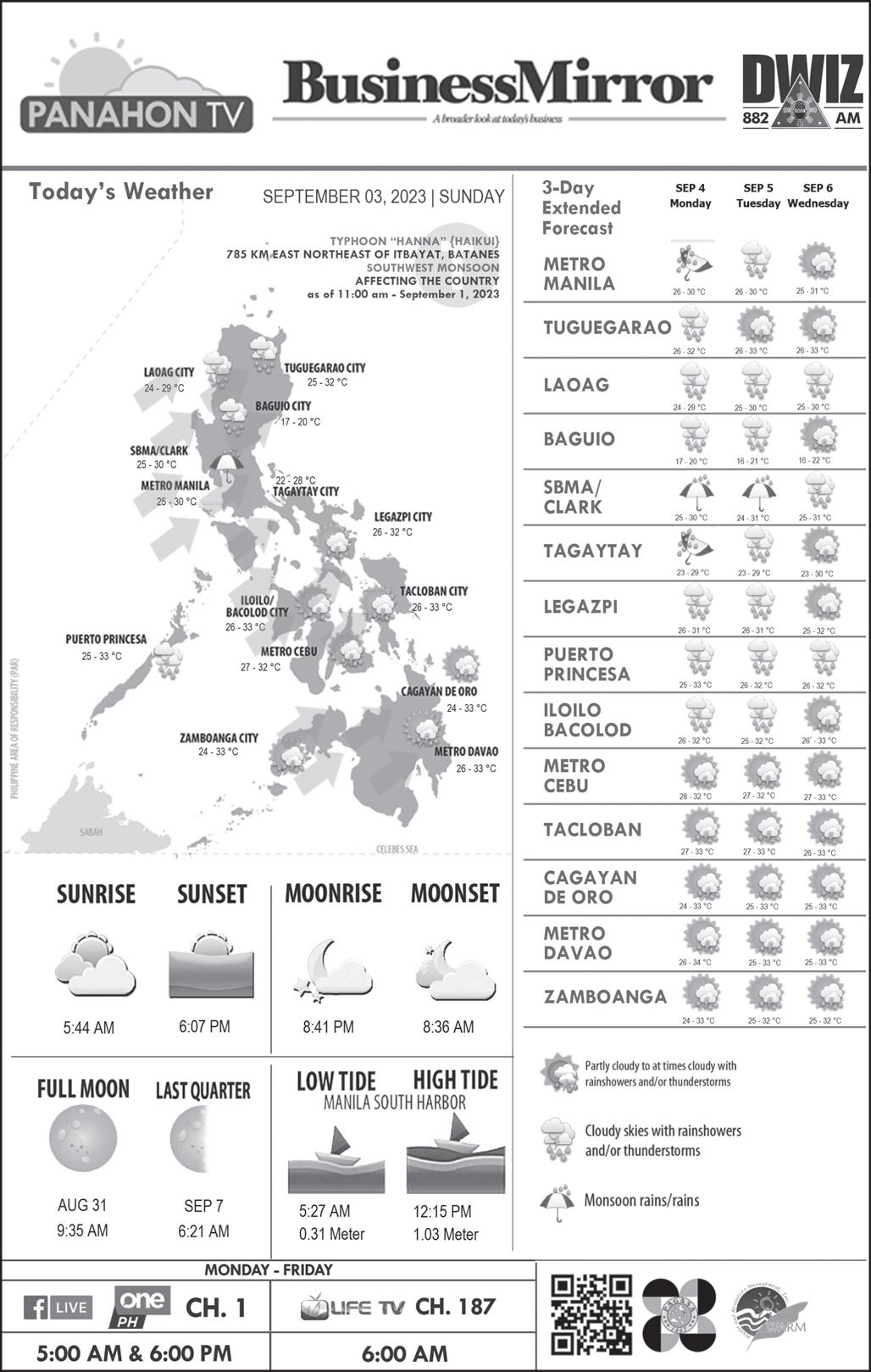
Dr. Dely Po Go’s exploration of a collaborative journey with SB19 goes beyond the realm of music—it signifies the emergence of a visionary partnership that seeks to not only revolutionize the P-Pop scene but also foster a novel movement: the inception of a new P-Pop Culture, one intertwined with philanthropy and empowerment—a “Philanthropic Pop Culture.” Dr. Go, with her keen insight and compassionate spirit, envisions a future where music is a catalyst for change, where every note sung by SB19 carries a message of unity and empowerment. She believes that this imminent partnership with SB19 resonates profoundly with their shared commitment to inspiring and uniting individuals.

Citadel vets 69,000 intern applicants to find next math, computer geniuses
By Lulu Yilun ChenThe two jacked-up security guards sitting outside the hall signal this is no ordinary summer camp: The students flew business class from as far away as California and Singapore to spend several nights at the five-star Fullerton Ocean Park Hotel in Hong Kong. Trays of crab meat salad, mini croque-monsieurs and skewers of prosciutto and melon sat nearby.
The highly sought-after interns were hand picked from 69,000 applicants by billionaire Ken Griffin’s lieutenants at Citadel and Citadel Securities LLC, as the finance giant looks to groom the next generation of math and computer whizzes that have helped it become one of the key components for market trading.
Over three days, the students will play the role of hedge fund traders, negotiating with counterparts, writing code, and devising automated strategies based on simulations with news feeds and macro data. It’s all part of a roughly 11-week program to prepare them for the often-secretive world of trading and market-making, earning about $120 an hour along the way, or $19,200 a month.
“There’s only a finite pool of truly exceptional students,” said Kristina Martinez, Citadel’s managing director in charge of human resources in Asia-Pacific. “Because of the complexity of what we do and the fact that companies that intersect with us will be looking at the same people, we need to get in early.”
Griffin, 54, the world’s 33rdrichest person, knows a thing or two about student potential. He got his finance career started at Harvard University, trading convertible bonds from his dorm, asking janitors to set up a satellite dish on the roof so he could get live prices. He’s parlayed that
to a personal fortune now worth about $37 billion. His Citadel Securities has become a key part of the plumbing underlying the US stock market through its ability to execute $463 billion in trades a day— sometimes buying or selling shares themselves—acting as a counterparty and offering liquidity at the same time.
Math and coding are increasingly desired skillsets for staff at banks and investment firms around the world, but it’s particularly so at Griffin’s firms where quantitative researchers and engineers devise trading strategies and deploy algorithms to automate the process.
The Hong Kong boot camp is one of many around the world for Miami-based Citadel, as Asia takes on a bigger focus given the company’s expansion in the region. Citadel, the hedge fund business, and Citadel Securities, the market maker, have doubled staff in Asia since 2020 to more than 400 people, even as some Wall Street firms pull back from the region.
During the summer program, the interns are each assigned a big project, as they work alongside the two firms’ army of staff who collectively generated $35.5 billion in revenue last year. A few select interns receive offers to come back within weeks after the program to take full-time jobs, while others rejoin part-time as early as their sophomore years.
“It was so different, none of my previous internships offered an off-site like this,” said Taylor, who asked to be identified only by her first name due to privacy concerns. “The projects that they asked us to work on were put to use in real applications, super challenging and exciting.”
As one of the fewer than 1
percent who made it to the internship this year, Taylor stood out given her prior stints at some of the largest tech companies including Meta Platforms Inc. A computer science major at the National University of Singapore, she moved to the city-state from Hebei, China when she was about 14 to attend high school after acing a test for gifted students.
Math olympiad
BEFORE joining Citadel, she had no financial industry knowledge, but had an avid interest in math, underscoring the type of talent that Citadel seeks. Almost without exception, the interns come from the most prestigious universities in their regions, some boasting math Olympiad Gold prizes or math doctorates from Stanford University in California. MBAs rarely make the cut.
One employee joked that Citadel was living proof of China’s old adage that “if you learn math, physics and chemistry well, you can conquer the world.”
Still, strong competency in those subjects is just a starting point, said Martinez.
“The person who’s just kind of awesome at academics, but has not done something above and beyond and not really demonstrated excitement around something, that’s probably not the candidate who’s going to thrive,” she said, in an interview in Hong Kong. “You’re assessing on potential” because “the problems that they face here, it’s not that we really know the answer either.”
Over the nearly three-month program, the students are evaluated on skills that go well beyond algebra. These include their level of
curiosity and ability to take feedback and ask the right questions. They’re gauged on how well they collaborate with teammates, and how fast they adapt and pivot when new information is presented. It’s an intricate balance: they have to compete with each other and be a team player at the same time.
No surprises
AT the off-site, around lunch time, one student cheekily vows not to eat too much to avoid a mental dip before the rigorous trading simulation in the afternoon.
The students were split into groups, with each assigned a Citadel staffer to provide guidance but not answers. Over the next few hours, they were expected to create algorithms to hedge their risk and identify arbitrage opportunities, part of the training to help them understand the market-making process.
What they don’t know is that their behavior and interaction with each other is also part of the test.
“Unlike job interviews, the intern program is packed with real-time problem solving, social, learning and highly interactive activities,” said Martinez. “There are no surprises by the end of the process.”
Even meals are a test. One of the many markers for the students is their interaction with company leaders during networking dinners, which this year were held at the chic Madame Fu and Porterhouse restaurants in Hong Kong.
To be fair, the students aren’t flying blind. Citadel brings in professional trainers to groom them, with exercises that include writing an e-mail to a boss by condensing a rambling,
As rates near their peak, pain begins for Europe’s borrowers
By Libby Cherry & Greg RitchieINTEREST-RATE hikes may be peaking in Europe, but for the consumers, companies and governments that borrowed trillions of euros during the era of ultra-low borrowing costs, there’s still plenty of pain in store. Through the end of this decade, borrowers across the continent face repayment on a mountain of debt sold when financing costs were many times lower. Although the adjustment is painful in many places, including the US, it’s a particular shock in Europe, where interest rates were below zero for eight years. Many borrowers have delayed refinancing in the hope that rates would come tumbling down again. But with economies having largely performed better than expected, that’s looking increasingly unlikely.
Investors predict that the coming years will be marked with defaults and spending cuts as a larger portion of corporate, household and state income goes into
financing debt. A stark indicator of the approaching sea change is the gap between what governments and companies globally are currently paying in interest and the amount they would pay if they refinanced at today’s levels. Apart from a few months around the global financial crisis, the gauge has always been below zero. Now it’s hovering around a record high of 1.5 percentage points.
“If your bet was the 2010s was the new normal where rates kept falling and you can always refinance, this is a really difficult environment,” said Mark Bathgate, a former Goldman Sachs Inc. and BlueBay Asset Management investor who now runs his own advisory firm. “ The issues in European credit could be a lot worse than in the US. T here was a lot more scope for excessive leverage to be built up.” Milton Friedman first coined the idea of long and variable lags in monetary policy in the 1960s. Put simply, it’s the uncertain lapse of time before changes in monetary policy start to impact the economy. While the price of assets such as government bonds often moves
in anticipation of, or immediately after, a central bank decision, it takes time for rate shifts to feed into longer-term contracts, and so into price-setting, labor markets and, eventually, inflation. For companies, many of which borrowed heavily during the pandemic, the big refinancing wall starts in 2025 and peaks in 2026. High-yield firms in Europe have over $430 billion of debt due in the second half of the decade, according to data compiled by Bloomberg.

“During the vintage years of easy money there wasn’t as much consideration given to what a high interest-rate environment might look like,” said Danielle Poli, a portfolio manager at Oaktree Capital Management.
“We still see stress brewing ahead for some borrowers, especially those that have more aggressive capital structures.”
To be sure, defaults among the riskiest companies aren’t expected to get anywhere near the 13.4 percent rate seen during the global financial crisis. Moody’s Investors Service forecasts that the global default rate for junk-rated companies will surpass
163-word note down to fewer than 60 words.
Another involves videotaping themselves for a self-introduction, where they are taught to project their voice, match their facial expression to their message, and avoid the pitfalls of filler words and up-speak intonation. They’re also given personality tests and taught how to seek feedback by summarizing what other people say.
Talent fight
THE reason Citadel spares no resources to train these students is because of the intense battle for top-tier talent.
Griffin’s firms are competing with the likes of Meta, ByteDance Ltd. and Alphabet Inc. among technology giants, along with marketmaker rivals including Optiver Holding BV, Jane Street Capital LLC and Susquehanna International Group.
For finance jobs across the US, median intern pay jumped 19 percent at 16 top firms studied by Levels.fyi, which analyzes compensation data submitted by users. At hedge funds and prop-trading firms, hourly pay surged 29 percent year-over-year to $111, with Citadel among the top of the pay list. Hedge funds and banks are also competing for talent against industries with fewer resources, including medical research that could benefit from AI and quant analysis skills.
Many finance interns get other benefits, including signing bonuses, living stipends and access to corporate housing, with pay packages similar to full-time employees. At top-tier Wall Street banks, five-star hotels, business-class flights and structured internships have become standard, said Tony Ernest, managing partner in Singapore for hedge fund talent consultancy Monroe Partners Asia.

“Gone are the days when interns did dog work,” he said, adding that if the internship goes well “it’s a great sales tool to get other students at the same schools interested.”
Campus recruiting now starts much earlier than before, and often lasts all year. Human resources departments are no longer just funneling stacks of resumes to hiring managers and doing oneoff school visits.
“Never did hedge funds go to campus 10 years ago,” said Ernest.
“Now they are soaking up the top 1 percent of graduates.”
Target profs
MARTINEZ and her team take a targeted approach, identifying professors at schools like Stanford and National University of Singapore that have a track record of grooming people who thrive at the company. They also unearth students through its Datathons, where participants work through large, complex datasets and present their findings.
First and second-year students can put themselves on the radar via Discover Citadel, where the top 40 to 50 applicants out of thousands are invited for a one or two-day event. The company also uses targeted recruiting and referrals to identify high-potential candidates, who are then invited to dinner sessions in cities including Hong Kong, New York and Singapore.
While Citadel and Citadel Securities don’t disclose their hiring rate, only “the truly outstanding” make the cut, Martinez says.
“Usually very early on in the internship you can identify the stars, the truly exceptional ones and this is when we tell the managers to go learn everything about who they are as individuals’’ to secure their return, she said.
Final project BACK at her Citadel office desk in Singapore, Taylor is racing against time to wrap up her big project. The tasks assigned to every intern are different—depending on whether they work on quantitative research, trading or operations— but they all involve actual problems facing the business. They’re expected to do a 15-minute presentation showcasing their work, and their solutions could be put to use. For Taylor, who was asked to improve the efficiency of a specific program, her big takeaway was “to think bigger, not just focus on the issues in front of you, but more of the why and impact.”
As part of the off-site training, the students volunteered at a charity, packaging and deliveri ng meals in Hong Kong. In true Citadel fashion, they were divided into groups, competing to be the fastest team.
the historical average by the end of this year, before peaking at 4.7 percent in March 2024. F or Europe, it’s predicted to peak around 3.8 percent in the middle of next year. For most firms, higher rates are more likely to lead to a drop in capital expenditure, which in turn will weigh on economic growth.
Companies in Europe, the Middle East and Africa bought back bonds at the fastest pace since 2009 in the first five months of year to trim leverage and cut interest payments. Others have sought to lengthen the maturity of their existing debt. While this is often sweetened with a pick -up in the coupon, it’s cheaper than going to the market and attracting new investors with a fresh debt issue.
Bank of England researchers estimate that highly-leveraged companies account for around 60 percent of UK corporate debt, but only 5 percent of the cash. This means these firms are more likely to reduce investment or jobs in order to stay afloat.
Companies may need to start raising funds for refinancing up to a year before
debt comes due in case they need to find new lenders, according to Jochen Schönfelder, a senior partner at B oston Consulting Group in Cologne. He’s already seen firms in Germany cutting back costs and says some are turning to private debt funds if they need cash fast. “Many expect some of the most important sectors in Germany, such as construction and automotive suppliers, to get worse,” Schönfelder said. “The big question is if this will also spill over into plant equipment, machinery, equipment suppliers, and also how private consumption will be affected.”
The pain for consumers will mostly be felt through rising mortgage costs and in many countries the rise in interest rates hasn’t yet followed through into monthly payments. The effective interest rate on outstanding home loans in the UK was below 3 percent as of the end of June, according to the Bank of England, compared with ar ound 6.7 percent for the average new two-year fixed product, according to data from Moneyfacts. Sweden may serve as a barometer of the pain in store for other countries. Swedish new mortgage holders saw their borrowing costs as a proportion of income double to
10 percent in 2022, the highest level in at least a decade, according to the country’s Finansinspektionen. That’s caused property prices to plummet, triggering a raft of insolvencies and requests for debt waivers among builders. Another potential pressure point for the continent is the fact that periphery economies like Italy and Portugal have a higher proportion of outstanding floating-rate mortgages. This “remains one of the main risks for a monetary policy hard landing where the weakest economies suffer most,” analysts at Bank of America including Claudio Irigoyen wrote in a recent note to clients.
The higher interest pain is already starting to weigh on state finances. Globally, sovereigns rated by Fitch Ratings face around $2.3 trillion in interest in 2023, representing an increase of nearly 50 percent for developed markets since 2020. For countries like the UK, where a quarter of government debt is linked to inflation, the burden is higher still. Last month was the most expensive for interest costs of any July on record, according to the latest public finances data. With assistance from Jana Randow/Bloomberg
IN a hotel ballroom overlooking the South China Sea, 24-year-old Taylor sits with 13 other university students in hoodies and sneakers coding away on laptops during their school break.KEN GRIFFIN CHRISTOPHER DILTS/BLOOMBERG
Workers exposed to extreme heat have no consistent protection in US
By Gabe Stern The Associated Press/Report for AmericaBut last summer, while on a construction crew in Las Vegas, he reached his breaking point. Exposure to the sun made his head ache immediately. He lost much of his appetite. Now at a maintenance job, Brizuela, 47, is able to take breaks. There are flyers on the walls with best practices for staying healthy—protections he had not been afforded before.
“Sometimes as a worker you ask your employer for protection or for health and safety related needs, and they don’t listen or follow,” he said in Spanish through an interpreter.
A historic heat wave that began blasting the Southwest and other parts of the country this summer is shining a spotlight on one of the harshest, yet least-addressed effects of US climate change: the rising deaths and injuries of people who work in extreme heat, whether inside warehouses and kitchens or outside under the blazing sun. Many of them are migrants in lowwage jobs.
State and federal governments have long implemented federal procedures for environmental risks exacerbated by climate
change, namely drought, flood and wildfires. But extreme heat protections have generally lagged with “no owner” in state and federal governments, said Ladd Keith, an assistant professor of planning at Arizona State University.
“In some ways, we have a very long way to catch up to the governance gap in treating the heat as a true climate hazard,” Keith said.
There is no federal heat standard in the US despite an ongoing push from President Joe Biden’s administration to establish one. Most of the hottest US states currently have no heat-specific standards either.
Instead, workers in many states who are exposed to extreme heat are ostensibly protected by what is known as the “general duty clause,” which requires employers to mitigate hazards that could cause serious injury or death. The clause permits state authorities to inspect work sites for violations, and many do, but there are no consistent benchmarks for determining what constitutes a serious heat hazard.
“What’s unsafe isn’t always clear,” said Juanita Constible, a senior advocate from the National Resources Defense
Council who tracks extreme heat policy. “Without a specific heat standard, it makes it more challenging for regulators to decide, ‘OK, this employer’s breaking the law or not.’”
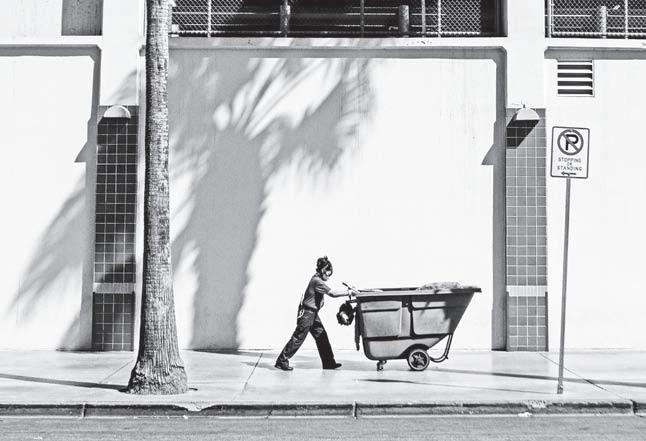
Many states are adopting their own versions of a federal “emphasis” program increasing inspections to ensure employers offer water, shade and breaks, but citations and enforcement still must go through the general duty clause.
Extreme heat is notably absent from the list of disasters to which the Federal Emergency Management Agency can respond. And while regional floodplain managers are common throughout the country, there are only three newly created “chief heat officer” positions to coordinate extreme heat planning, in Miami-Dade County, Phoenix and Los Angeles.
Federal experts have recommended extreme heat protections since 1972, but it wasn’t until 1997 and 2006, respectively, that Minnesota and California adopted the
first statewide protections. For a long time, those states were the exception, with only a scattering of others joining them throughout the early 2000s.
But as heat waves get longer and hotter, the tide is starting to change.
“There are a lot of positive movements that give me some hope,” Keith said.
Colorado strengthened existing rules last year to require regular rest and meal breaks in extreme heat and cold and provide water and shade breaks when temperatures hit 80 degrees Fahrenheit (26.7 degrees Celsius). Washington state last month updated 15-year-old heat safety standards to lower the temperature at which cool-down breaks and other protections are required. Oregon, which adopted temporary heat protection rules in 2021, made them permanent last year.
Several other states are considering similar laws or regulations.
Arizona Gov. Katie Hobbs recently announced new regulations through the heat emphasis program and declared a state of emergency over extreme heat, allowing the state to reimburse various government entities for funds spent on providing relief from high temperatures.
Nevada also adopted a version of the heat emphasis program.
But a separate bill that would define what constitutes extreme heat and require employers to provide protections ultimately failed in the final month of the legislative session.
The measure faltered even after the temperature threshold for those protections was increased from 95 degrees Fahrenheit (35 degrees Celsius) to 105 (40.5 degrees Celsius). Democratic lawmakers in Nevada are now trying to pass those protections through a regulatory process before next summer.
The Biden administration introduced new regulations in 2021 that would develop heat safety standards and strengthen required protective measures for most at-risk private sector workers, but the mandates are likely subject to several more years of review. A group of Democratic US Congress members introduced a bill last month that would effectively speed up the process by legislating heat standards.
The guidelines would apply to all 50 states and include private sector and select federal workers, but leave most other public sector workers uncovered. Differing conditions across states and potential discrepancies in how the federal law would be implemented make consistent state standards crucial, Constible said.
For now, protections for those workers are largely at the discretion of individual employers.
Eleazar Castellanos, who trains workers on dealing with extreme heat at Arriba Las Vegas, a nonprofit supporting migrant and low-wage employees, said he experienced two types of employers during his 20 years of working construction.
“The first version is the employer that makes sure that their workers do have access to water, shade and rest,” he said in Spanish through an interpreter. “And the second type of employer is the kind who threatens workers with consequences for asking for those kinds of preventative measures.” Heat protection laws have faced steady industry opposition, including chambers of commerce and other business associations. They say a blanket mandate would be too difficult to implement across such a wide range of industries.
“We are always concerned about a one-size-fits-all bill like this,” Tray Abney, a lobbyist for the National Federation of Independent Businesses, told Nevada legislators.
Opinions vary on why the Nevada bill failed after passing the Senate on party lines. Some say it was a victim of partisan politics. Others say there were too many bills competing for attention in a session that meets for just four months every other year.
“It all comes down to the dollar,” said Vince Saavedra, secretarytreasurer and lobbyist for Southern Nevada Building Trades. “But I’ll challenge anybody to go work outside with any of these people, and then tell me that we don’t need these regs.”
Stern is a corps member for the Associated Press/Report for America Statehouse News Initiative. Report for America places journalists in local newsrooms across the country to report on undercovered issues.
London is now the world’s largest low-emissions zone. Was the fight worth it?
By Jess Shankleman & Olivia RudgardEVERY driver in London, as of Tuesday,
is now subject to strict pollution rules, completing one of the world’s most ambitious vehicle emissions policies and taking the British capital closer to having healthy air.
W hile the final expansion of the ULEZ, or ultra low emissions zone, is only a continuation of clean air charges that have been tightening since 2008—under Boris Johnson when he was mayor of London and now his successor Sadiq Khan—this last phase has been the most controversial. That’s because the £12.50 ($15.72) per day levy for most non-compliant vehicles now hits those living in outer boroughs of London, where people tend to be more car dependent and have lower incomes.
The ULEZ expansion wasn’t even guaranteed until July when London’s High Court ruled against Conservative-led local authorities who had sued over the plans to grow the zone.
The pollution charges particularly target older diesel vehicles, which tend to create more harmful concentrations of nitrogen dioxide (NO2) in the air than petrol because of the differences in the way the fuel is combusted. For Khan, the battle to tackle these emissions has been worth it. As a sufferer of adult onset asthma, he’s made London’s air quality a personal mission.
And while some political opponents think the mayor has gone too far with the ULEZ,
others say he isn’t doing enough to reduce traffic smog.
In order to get a sense of the likely impact of the latest ULEZ expansion, it helps to look at the ways transport and pollution in the city have already changed since the previous phase was rolled out four years ago. Here’s what to expect from London’s newest clampdown on tailpipe emissions and the influence it’s having on clean air policies worldwide.
‘Magic’ guidelines
A DECADE ago London had NO2 levels that were among the worst of major world cities, and that has improved dramatically alongside the expansion of the ULEZ. At its most severe, NO2 can lead to reduced lung development and respiratory infections in children and breathing difficulties in early adulthood, as well as premature death.
The decline in NO2 pollution seen since 2017 can’t just be attributed to ULEZ. Internal combustion engine cars, both diesel and petrol, have become much cleaner over time as standards have tightened. There are more affordable electric vehicles on the market and buses and taxis have also become less emitting.
The benefit to London’s outer-borough residents, which have the highest number of deaths linked to air pollution, has been used by Khan as a major argument for its expansion. Analysis released by the mayor’s office in June suggests that, based on analysis of income, education, crime levels and other factors, poorer Londoners
and those from immigrant communities are more likely to live in areas with worse air quality.
Yet even with the expanded ULEZ, no Londoners will live in areas that meet the tougher new World Heath Organization’s annual average guidelines of 10 micrograms per cubic meter of air for NO2 or 5 micrograms per cubic meter of air for PM2.5, which are fine particles emitted by cars, industry and other harmful sources.
“I don’t think the expansion of ULEZ will be sufficient in the longer term,” said Frank Kelly, a professor at Imperial College London who has worked on air pollution science for 30 years. “Even though it’s had a big impact in central and inner London, the concentrations of pollutants still are too high. So other measures will need to be introduced in due course if we’re going to get down to those magic WHO guidelines.”
‘Hammering down on diesel’
SIMON BIRKETT, who founded the campaign Clean Air in London, said he’d like to see the next mayor take things a step further and completely ban diesel vehicles on the city’s roads. But already sales of new diesel cars in London have been declining, he noted, falling to about 5,400 in 2022, from a peak of almost 69,000 in 2016. “The ULEZ has been hammering down on diesel,” Birkett said.
At the same time, London has seen a huge growth in the number of electric vehicles on the roads, from less than 3,000 registered a decade ago to almost 75,000 by the first quarter of this year.
The drivers most likely to be stung by the
ULEZ expansion are commercial van owners. Unlike cars, the van market is still dominated by diesel—more than 90 percent of vans are diesel-fueled. Data suggests that just under half of vans registered to addresses in the outer boroughs of the city are not ULEZ compliant, though the mayor’s office disputes the relevance of this data, arguing that many of those vehicles are not actually driven in London. It uses data collected from road-monitoring cameras, which suggests 80 percent of vans are ULEZ compliant.
Some small business groups have raised opposition to an extra charge on vans, citing the financial burdens this can create for their business. In response to concerns, Khan expanded a vehicle scrappage scheme, once only available to a limited number of recipients, to all drivers of non-compliant vehicles. Still, this only covers those people living in London and not those on the borders who may need to commute into the capital daily.
The scheme offers £2,000 ($2,515) for a car driver to scrap a non-compliant vehicle, or £7,000 ($8,804) for a van. The scrappage grant is worth even more if drivers opt to take a voucher for public transport as part of the payment. During the previous phase of the scheme, introduced two years ago, some 15,000 cars, vans and motorcycles were scrapped.
One of the biggest arguments against the ULEZ expansion has been that new areas brought into its scope have poorer public transport options than central London, where the policy started. People in outer
London are less likely to live within walking distance of a bus stop or train station. In areas with less access to public transport, people are more likely to have a car.
In response, Khan is also pledging more funds for public transport, paid for by any fines charged under the ULEZ scheme. This includes a bus “Superloop,” which promises travel for £1.75 around outer London. The full network has yet to be introduced and consultations are still ongoing.
Toxic politics
WHILE previous ULEZ phases were rolled out without much controversy, this final expansion into the suburbs has become politically toxic, potentially costing Khan’s Labour Party the chance to win Johnson’s former parliamentary seat in the outer London borough of Uxbridge in July.
That loss has split Khan and Labour leader Keir Starmer, who in July said the mayor should “reflect” on the ULEZ after the election defeat and said the country needed to find a new way of tackling transport pollution. It also prompted Conservative Prime Minister Rishi Sunak to try to capitalize on the division, declaring he’s “on the side of motorists,” launching a review of pollution cutting policies, such as low traffic neighborhoods and 20 mileper-hour speed limit zones.
While the mayor’s office claims that nine in 10 drivers will comply with the new rules, that figure has been contested.
Like the van data, this figure comes from traffic cameras, whereas Bloomberg’s
analysis of Driver and Vehicle Licensing Agency data found that at least 15 percent of cars licensed in outer London will not be compliant with ULEZ.
Valuable lessons
NOW the largest in the world, the progress of London’s pollution charging zone has been watched by mayors from Bogota to Montreal, who’ve been inspired to introduce their own control districts for vehicle emissions.
“L ondon’s Ultra Low Emission Zone has been a reference for Bogota’s air quality agenda,” Claudia Lopez, the mayor of Bogota, said in 2021. Montreal’s mayor Valerie Plante, who is laying the groundwork for a low-emission strategy in her city, has also highlighted ULEZ’s achievements.
Meanwhile, Giuseppe Sala, mayor of Milan, said in a recent Guardian article that he’s been particularly impressed by the measures designed to ease the burdens of ULEZ’s expansion – from the scrappage scheme to public transport investment – as he seeks to curb his city’s traffic problems.
To be sure, all cities have their own unique vehicle pollution concerns, but Birkett said London has at least provided real data on what actions can work at scale.
While diesel is a particularly serious problem in Europe, that requires large, strong ultra low emission zones, ULEZ expansion in London has valuable lessons for other cities around the world,” he said. With assistance from Mathieu Dion and Jack Ryan/Bloomberg
RENO, Nev.—Santos Brizuela spent more than two decades laboring outdoors, persisting despite a bout of heatstroke while cutting sugarcane in Mexico and chronic laryngitis from repeated exposure to the hot sun while on various other jobs.A MAINTENANCE worker pushes a refuse cart in the sun on Friday, August 25, 2023, in Las Vegas. A historic heat wave that began blasting the Southwest and other parts of the country this summer is shining a spotlight on one of the harshest, yet least-addressed, effects of climate change in the US: the rising deaths and injuries of people who work in extreme heat, whether inside hot warehouses and kitchens or outside under the blazing sun. Many of them are migrants in low-wage jobs. AP/TY O’NEIL
DOST partners with US firms via US-Asean Business Council
DEVELOPMENT of smart cities, quantum technology, digital transformation, advanced weather forecasting, and the facilitation of health technology assessment (HTA) initiatives were among the points of interest of the companies during the annual US-Asean Business Council 2023 Philippine Business Mission meeting held recently at a hotel in Pasay City.
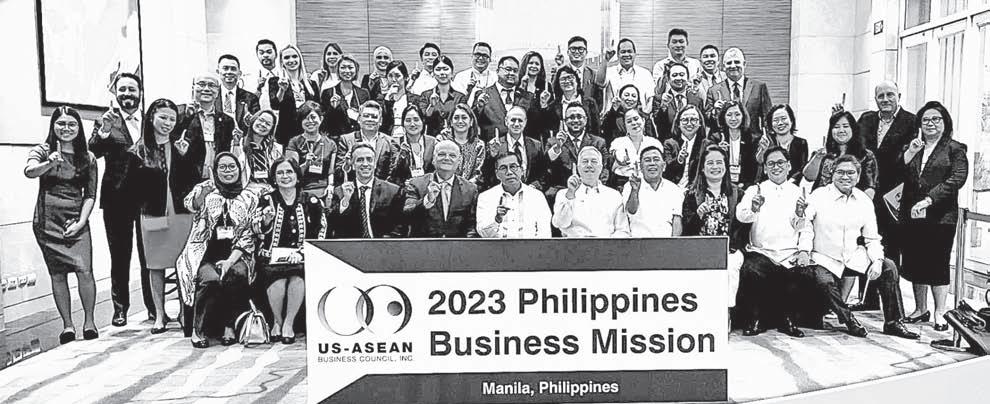
Rare blue supermoon dazzles stargazers around the globe
ARARE blue supermoon— the closest full moon of the year than usual and appearing especially big and bright—dazzled stargazers
Wednesday night.
Saturn joined the celestial spectacle, visible alongside the moon, at least where skies were clear.
It was the second full moon of August, thus the blue label. And it was unusually close to Earth, therefore a supermoon.
The moon appeared to be bigger and brighter than usual, given its close proximity to Earth: just 222,043 miles (357,344 kilometers) or so. The August 1 supermoon was more than 100 miles (160 kilometers) farther away.
If you missed it, it will be a long wait: The next blue supermoon isn’t until 2037. But another regular supermoon is on the horizon at the end of September, the last one of the year.
 Marcia
Marcia
PhilSA receives support from DFNN for natl space capacity building
THE Philippine Space Agency (PhilSA) received and signed a Pledge of Support from digital technology leader DFNN Inc. to establish a sustainable pool of trained workforce that will be instrumental to the success of the country’s national space programs.
The signing ceremony was held at the PhilSA office in Quezon City on August 14 as part of the inaugural Philippine Space Week celebrations.
DFNN Inc. Executive Chairman Ramon C. Garcia Jr. signed the pledge that was received by PhilSA Director General Dr. Joel Joseph Marciano Jr.
A trailblazer in digital technology solutions, encompassing diverse industries, including gaming and fintech, DFNN’s support to PhilSA is part of its mission of creating innovation that sustains the growth of its partners and stakeholders.
It’s goal is to further nurture the local space ecosystem through strategic collaboration and capacity-building.
The Pledge of Support includes the provision of a Learning Management System platform, scholarships for space-related studies and internship opportunities with DFNN’s partner space industry facilities to PhilSA, which shall work with DFNN in finalizing the implementation of the donation.
As part of sustaining the momentum of the local space ecosystem’s growth, DFNN recognizes that meaningful partnerships are an essential driver of this endeavor.
“We hope DFNN’s learning management system donation will help accelerate learning within the agency, specifically in key areas of study that the PhilSA would like to train its workforce on,” Garcia said.
Marciano, on the other hand, said: “Private sector engagement and cooperation is crucial in creating a robust and thriving space industry that supports ‘Yamang Kalawakan’ and the national space program. We value the generous support of DFNN Inc. through this donation pledge, and we will work closely to open and multiply these opportunities to fellow Filipinos.”
PhilSA and DFNN share the vision of fostering local innovations in space through synergy, exemplified by the support for impactful capacity-building initiatives for the Philippine space sector.
This is also in line with the DFNN’s corporate social responsibility objective of contributing to nation building through sharing of resources and expertise and forming strategic collaborative networks that ensure the enduring flow of knowledge and innovation in the country.
The US-Asean Business Council represents over 175 US companies, including many of the world’s largest firms with operations in Southeast Asia.
During the Business Mission, senior representatives from member companies went to the Philippines to engage with priority stakeholders, reinforcing the importance of US-Philippines business relations.
With the meeting mission theme, “Forging Sustainable and Transformational Partnerships for Economic Growth,” Science Secretary Renato U. Solidum Jr. led the Department of Science and Technology (DOST) in welcoming the opportunity to collaborate with the private sector in science, technology and innovation (STI).
The strategic partnership was expected to bring benefits, such as knowledge exchanges, technological breakthroughs and finding innovative solutions that can improve the STI efforts of the country.
For DOST, research and development projects on OneLab Network; Small Enterprise Technology Upgrading Program; Community Empowerment Through Science and Technology, and the areas of cooperation as outlined in the 2019 memorandum of understanding (MOU) with the USAsean Business Council were envisioned to be continued.
These involve research and development (R&D) programs focused on upgrading and supporting countryside development and empowering the poorest communities in the country through S&T interventions in health and nutrition, water and sanitation, basic education and literacy, livelihood/ economic enterprise development, and disaster risk reduction and
climate change adaptation.
The 2023 meeting focused on sustainable development, transformative digitalization, collaboration on innovative healthcare solutions, advanced manufacturing and supply chains, and ease of doing business.
During the business mission, the following 12 member companies expressed their interest to collaborate with DOST:
n IBM is keen to engage with DOST on quantum technology, given its prominent position as a leader in the field. Having established collaboration on quantum technology with Korea, Singapore, and India, it is prompted by the need to formulate a robust quantum strategy for the Philippines by building a quantum ecosystem and nurturing relevant skills. It acknowledged the existing strong skill foundation in the Philippines but emphasized the necessity of accelerating efforts in the quantum realm.
n MSD is open to partnering with DOST to share their experiences and best practices, contributing to the enhancement of HTA capabilities and standards. It is also committed to extend to supporting technology transfers on startups.
n Oracle is focusing on smart cities and potential collaborations with the local government units. It said it can be a strong partner in enhancing the productivity and efficiency of government service deliveries and upskilling the government’s human resources. Oracle is also keen to
actively contribute in advancing R&D, and is interested in DOST’s Science for Change Program.

n Qualcomm has been engaging and having technical discussions with Philippine Council for Industry and Energy Research and Development, and Advanced Science and Technology Institute regarding 5G and CV2x. Both PCIEERD and ASTI are interested in Qualcomm serving as technical advisors and maintaining periodic interactions.
n Viatris, a global healthcare company in cardiovascular health, pain, mental health, HIV, AIDS and Hepatitis B, would like to support the plans of the DOST in the HTA research network, strengthening HTA capacity and capability building in the Philippines, and facilitating broader access to innovate medical technologies.
n Pfizer, which will have its 70th year of operation in the Philippines in 2024, emphasized their dedication to healthcare, and science and technology in the country, and are committed to support its HTA. Pfizer is also keen to share their best practices to the Virology and Vaccine Institute of the Philippines.
n SC Johnson, a global expert in pest control dedicated to protecting consumers against mosquitoborne diseases, is keen to explore a collaborative partnership with DOST to establish a technical working group.
n Roche, one of the largest biological companies globally, would like to engage in data exchange with DOST. It hopes that in HTA
decision-making, DOST will consider the societal cost of diseases and their broader impact on the general population.
n KKR is one of the largest private capital investors globally. In the past five years, it has directly invested $2 billion into Philippine enterprises. Its investments include Metro Pacific Hospital, Maya, Voyager and Pinnacle Towers. It has also supported “Grow Sari” that is in delivering merchant services to sari-sari stores. KKR plans to continue to invest in the Philippines, and will await where DOST want it to invest. It is excited to build the capability for technology development in the country.

n Google is keen on fostering a partnership focused on artificial intelligence. It would like to collaborate with the DOST by partnering on Generative AI; enhancing the startup program, and supporting from Ideation to product decision.
n Salesforce have been active in the Philippines on capacity building, partnering with the Bulacan State University, Asia Pacific College and Mapua Institute of Technology. Salesforce would like to collaborate with DOST to extend its training initiatives, focusing on digital transformation, human resource development and digital governance.
n Atmo shared their positive productive experience collaborating with DOST. Atmo noted that they will sign a contract with DOST for an advanced AI-driven weather forecasting model for the Philippines. Lyn Resurreccion
Space junk will increase with future missions–but no one’s in charge of cleaning up
THERE’S a lot of trash on the Moon right now—including nearly 100 bags of human waste—and with countries around the globe traveling to the Moon, there’s going to be a lot more, both on the lunar surface and in Earth’s orbit.
In August 2023, Russia’s Luna-25 probe crashed into the Moon’s surface, while India’s C handrayann-3 m ission successfully landed in the southern polar region, making India the fourth country to land on the Moon. With more countries landing on the Moon, people back on Earth will have to think about what happens to all the landers, waste and miscellaneous debris left on the lunar surface and in orbit.
I’m a professor of astronomy who has written a book about the future of space travel, articles about our future off-Earth, conflict in space, space congestion and the ethics of space exploration.
Like many other space experts, I’m concerned about the lack of governance around space debris.
Space is getting crowded
PEOPLE think of space as vast and empty, but the near-Earth environment is starting to get crowded. As many as 100 lunar missions are planned over the next decade by governments and private companies like SpaceX and Blue Origin.
Near-Earth orbit is even more congested than the space between Earth and the Moon. It’s from 100 to 500 miles straight up, compared with 240,000 miles to the Moon.
Currently there are nearly 7,700 satellites within a few hundred miles of the Earth. That number could grow to several
hundred thousand by 2027.
Many of these satellites will be used to deliver internet to developing countries or to monitor agriculture and climate on Earth.
Companies like SpaceX have dramatically lowered launch costs, driving this wave of activity.
“It’s going to be like an interstate highway, at rush hour in a snowstorm, with everyone driving much too fast,” space launch expert Johnathan McDowell told Space.com.
Space junk problem
ALL this activity creates hazards and debris. Humans have left a lot of junk on the Moon, including spacecraft remains like rocket boosters from over 50 crashed landings, nearly 100 bags of human waste and miscellaneous objects like a feather, golf balls and boots.
It adds up to around 200 tons of our trash.
Since no one owns the Moon, no one is responsible for keeping it clean and tidy.
The clutter in Earth’s orbit includes defunct spacecraft, spent rocket boosters and items discarded by astronauts, such as a glove, a wrench and a toothbrush.
It also includes tiny pieces of debris like paint flecks. There are around 23,000 objects larger than 10 cm and about 100 million pieces of debris larger than 1 mm.
Tiny pieces of junk might not seem like a big issue, but that debris is moving at 15,000 mph, 10 times faster than a bullet. At that speed, even a fleck of paint can puncture a spacesuit or destroy a sensitive piece of electronics.
In 1978, NASA scientist Donald Kessler described a scenario where collisions between
orbiting pieces of debris create more debris, and the amount of debris grows exponentially, potentially rendering near-Earth orbit unusable.
Experts call this the “Kessler syndrome.”
Nobody is in charge up there
THE United Nations Outer Space Treaty of 1967 sa ys that no country can “own” the Moon or any part of it, and that celestial bodies should only be used for peaceful purposes.
But the treaty is mute about companies and individuals, and it says nothing about how space resources can and can’t be used.
The United Nations Moon Agreement of 1979 held that the Moon and its natural resources are the common heritage of humanity.
However, the United States, Russia and China never signed it, and in 2016, the US Congress created a law that unleashed the American commercial space industry with very few restrictions.
Because of its lack of regulation, space junk is an example of a “tragedy of the commons,” where many interests have access to a common resource, and it may become depleted and unusable to everyone, because no interest can stop another from overexploiting the resource.
Scientists argue that to avoid a tragedy of the commons, the orbital space environment should be seen as a global commons worthy of protection by the United Nations.
The lead author of a Naturearticle arguing for a global commons filed an amicus brief—a type of outside comment offering
support or expertise—on a case that went to the US C ourt of Appeals for the District of Columbia Circuit in late 2021.
The author and his research collaborators argued that US environmental regulations should apply to the licensing of space launches.
However, the court declined to rule on the environmental issue because it said the group lacked standing.
National geopolitical and commercial interests will likely take precedence over interplanetary conservation efforts unless the United Nations acts.
A new treaty may emerge from the work of the UN Office for Outer Space Affairs, which in May 2023 generated a policy document to address the sustainable development of activities in space.
The UN can regulate the activities of only its member states, but it has a project to help member states craft national-level policies that advance the goals of sustainable development.
NASA has created and signed the Artemis Accords, broad but nonbinding principles for cooperating peacefully in space. They have been signed by 28 countries, but the list does not include China or Russia.
P rivate companies are not party to the accords either, and some space entrepreneurs ha ve deep pockets and big ambitions.
The lack of regulation and the current gold rush approach to space exploration mean that space junk and waste will continue to accumulate, as will the related problems and dangers. Chris Impey, University of Arizona/The Conversations (CC) via AP
Pope to release 2nd ‘Laudato Si’’ on Oct. 4
VATICAN—Pope Francis said
Wednesday he will release a follow-up environmental document to the 2015 encyclical “Laudato Si’” (Praised Be) on October 4, the feast of Saint Francis of Assisi.
Speaking at the end of his general audience August 30, the pope said he plans “to publish an exhortation, a second Laudato Sì’,” at the end of a Vatican-supported ecumenical initiative that will run from September 1 to October 4. The Season of Creation will begin, Pope Francis said, on September 1, which is the World Day of Prayer for the Care of Creation. This year’s theme is “Let Justice and Peace Flow.”
“Let us join our Christian brothers and sisters in the commitment to care for creation as a sacred gift from the Creator,” Francis urged at his public audience.
“It is necessary to stand with the victims of environmental and climate injustice, striving to end the senseless war on our common home, which is a terrible world war,” he added. “I urge all of you to work and pray for it to abound with life once again.”
Pope Francis announced last week that he is writing a second part to his 2015 environmental encyclical Laudato Si’.
The pope said with this new writing he is updating Laudato Si’ to cover “current issues.”
The Holy See Press Office director, Matteo Bruni, confirmed to Catholic News Agency (CNA) on
August 21 that “the pope is working on a letter updating Laudato Si’ with regard to the recent environmental crises.”
Laudato Si’ is the second of three encyclicals published in Pope Francis’s pontificate thus far. It was released in June 2015.
The theme of the encyclical, which means “Praise be to you,” is human ecology, a phrase first

used by Pope Benedict XVI.
The document addresses issues such as climate change, care for the environment, and the defense of human life and dignity.
Pope Francis said on August 30 that the second part to Laudato Si’ would be the kind of papal document known as an “exhortation.”
Francis has so far published
Muslim call to prayer can now be broadcast in NYC
NEW YORK—The Muslim call to prayer will ring out more freely in New York City under guidelines recently announced by Mayor Eric Adams, which he said should foster a spirit of inclusivity.
Under the new rules, Adams said, mosques will not need a special permit to publicly broadcast the Islamic call to prayer, or adhan, on Fridays and at sundown during the holy month of Ramadan.
Friday is the traditional Islamic holy day, and Muslims break their fast at sunset during Ramadan.
The police department’s community affairs bureau will work with mosques to communicate the new guidelines and ensure that devices used to broadcast the adhan are set to appropriate decibel levels, Adams said.
Houses of worship can broadcast up to 10 decibels over the ambient sound level, the mayor’s office said.
“For too long, there has been a feeling that our communities were not allowed to amplify their calls to prayer,” Adams said.
“Today, we are cutting red tape and saying clearly that mosques and houses of worship are free to amplify their call to prayer
on Fridays and during Ramadan without a permit necessary.”
Flanked by Muslim leaders at a City Hall news conference, Adams said Muslim New Yorkers “will not live in the shadows of the American dream while I am the mayor of the city of New York.”
The adhan is a familiar sound in majority-Muslim countries but is heard less frequently in the United States.
Officials in Minneapolis made news last year when they moved to allow mosques to broadcast the adhan publicly.
The adhan declares that God is great and proclaims the Prophet Muhammad as his messenger. It exhorts men—women are not required—to go to the closest mosque five times a day for prayer, which is one of the Five Pillars of Islam.
“The sound of the adhan is not just a call to prayer; it is a call to unity, reflection, and community,” Afaf Nasher, the executive director of the New York chapter of the Council on American-Islamic Relations, said in a statement.
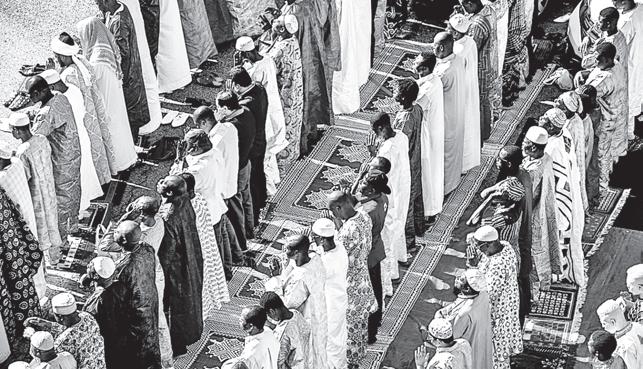
“We believe that this action
will contribute to greater understanding and appreciation of the Muslim community’s values and traditions,” he said.
Somaia Ferozi, principal of the Ideal Islamic School in Queens, said New York City’s new rules send a positive message to her students.
“Our children are reminded of who they are when they hear the adhan,” said Ferozi, who attended Adams’ news conference. “Having that echo in a New York City neighborhood will make them feel part of a community that acknowledges them.”
Adams, a Democrat, enjoys close relationships with faith leaders from various traditions and has promoted the role of religion in public life.
He has at times alarmed civil libertarians by saying he doesn’t believe in the separation of church and state.
“State is the body. Church is the heart,” Adams said at an interfaith breakfast earlier this year. “You take the heart out of the body, the body dies.”
A spokesperson for the mayor said at the time that Adams merely meant that faith guides his actions.
Karen Matthews/Associated PressMarian pilgrimage to celebrate Indigenous Peoples Sunday

ON its ninth year as a nonprofit Catholic pilgrimage apostolate, Green Faith Travels goes beyond Manaoag in Pangasinan and Baguio City for its Marian pilgrimage of faith, heritage to celebrate the holy rosary month of October.
Instead, the pilgrims will also pray in eight churches and visit the Bontoc and Ifugao museums in Cordillera Administrative Region’s provinces of Benguet, Mountain Province and Ifugao from October 6 to 8 to celebrate Indigenous Peoples Sunday.
The region comprises six provinces, including Abra, Apayao, and Kalinga with Baguio City as its regional center.
Marian devotees joining the ninth Marian Pilgrimage of Faith and Heritage will seek the intercession of the Blessed Mother at the Minor Basilica of Our Lady of the Rosary of Manaoag (1605), the most popular Marian pilgrimage site in the country, and
Our Lady of the Atonement, or Baguio Cathedral.
In Baguio City on October 6, the pilgrims will also pray at the Shrine of Our Lady of Lourdes (Lourdes Grotto) at Mirador Hill built in 1913; the church of Carmel of the Most Holy Trinity; the pilgrim garden of the Congregation of Our Lady of Charity of the Good Shepherd; Our Lady of Grace parish and Our Lady of the Pillar Chapel inside the Casiciaco Recoletos Seminary. On October 7, devotees will pray at the Holy Family Mission in Sad -
sadan, Bauko, Mountain Province; Teng-Ab Retreat House (with a talk on the Indigenous Peoples of the Cordillera) and Sta. Rita de Cascia Cathedral in Bontoc and the Immaculate Conception Mission in Banaue, Ifugao.
In Ifugao on October 8 to celebrate Indigenous Peoples Sunday, the pilgrims will pray at Saint Paul the Apostle Parish in Hingyon; Mary Magdalene Church and Saint Joseph Mission in Kiangan. Green Faith Travels will also visit the Most Rev. Valentin C. Dimoc, DD, bishop of the Apostolic
five apostolic exhortations during his pontificate, including Evangelii Gaudium (The Joy of the Gospel) and Amoris Laetitia (The Joy of Love).
The feast of St. Francis of Assisi was also the date in 2020 that Pope Francis chose to release his most recent encyclical, Fratelli Tutti, about fraternity and social friendship.
Catholic movement awaits 2nd papal document
A CATHOLIC movement in the Philippines has welcomed Pope Francis’ upcoming document aimed at protecting the environment.
The Laudato Si’ Movement
Pilipinas said what is needed are “concrete actions” to address most pressing environmental issues, which they hope will be tackled in the second part of the Laudato Sì’ encyclical.
“Laudato Si’ is very general in its orientation… so people are asking for concrete actions, and I presume that’s what will come out in the second part,” said Bro. John Din, Laudato
Si Movement Pilipinas (LSMP) national coordinator.
In Manila, this year’s commemoration of the Season of Creation was launched on August 29 by three networks: the Catholic Bishops Conference of the Philippines’ Episcopal Commission on Ecumenical Affairs (CBCP-ECEA), the Philippine Council for Evangelical Churches and the National Council of Churches in the Philippines (NCCP).
At a news briefing, activities for the month-long observance were announced, including the Weekly Walk for (and with) Creation.
Other initiatives, organizers said, aim to highlight environmental concerns, sites of struggle, and sites of care, such as oil spills, Manila Bay reclamation, seabed quarrying, and the proposed Kaliwa Dam.
“Today, all together, we are collaborating as one family as inhabitants of creation–of the whole world–to work together to save our planet,” said Robert Samson of CBCP-ECEA. Hannah Brockhaus/ CNA and Joseph Ryan Moscosa/CBCP News
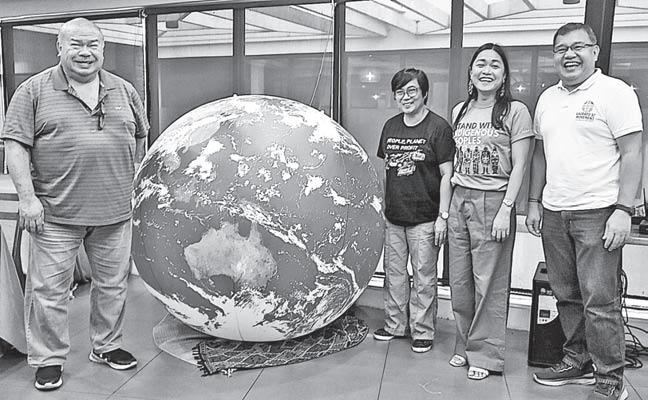
VATICAN CITY—When Pope Francis travels to Mongolia from September 1 to 4, he will in some ways be completing a mission begun by the 13thcentury Pope Innocent IV, who dispatched emissaries east to ascertain the intentions of the rapidly expanding Mongol Empire and beseech its leaders to halt the bloodshed and convert.
Those medieval exchanges between Roman pope and Mongolian khan were full of bellicose demands for submission and conversion, with each side claiming to be acting in the name of God, according to texts of the letters that survive.
But the exchanges also showed mutual respect at a time when the Catholic Church was waging Crusades and the Mongol Empire was conquering lands as far west as Hungary in what would become the largest contiguous land empire in world history.
Some 800 years later, Francis won’t be testing new diplomatic waters or seeking to proselytize Mongolia’s mostly Buddhist people. He arrived in the capital Ulaanbaatar on Friday for a four-day visit.
His trip is nevertheless a historic meeting of East and West, the first-ever visit by a Roman pontiff to Mongolia to minister to one of the tiniest, newest Catholic communities in the world.
“In a way, what’s happened is that both sides have moved on,” said Christopher Atwood, professor of Mongolian and Chinese frontier and ethnic history at the University of Pennsylvania.
“Once upon a time, it was either/or: Either the world was ruled by the pope, or the world was ruled by the Mongol Empire. And now I think both sides are much more tolerant,” Atwood said.
Vicariate of Bontoc-Lagawe and chairman of the Episcopal Commission on Indigenous Peoples at the Divine Mercy Shrine in Lagawe, Ifugao.
The group will also distribute school supplies, shoes, books and other educational materials, as part of its outreach activity during the pilgrimage.
Pilgrimage fee of P12,000 per person, which covers the use of airconditioned tourist bus, breakfast, lunch, dinner and snacks, water and juice drinks, a pilgrim’s kit and church donations.
Families and groups of friends with a minimum of five members will get a P1,000 discount for one pilgrim.
Deadline of payment is on September 8, 2023, feast of the nativity of the Blessed Virgin Mary.
Interested parties may call 0995-1195998; e-mail greenfaithtravels@gmail.com and greenfaithtravels@yahoo.com ; or visit www. facebook.com/greenfaithtravels.
Officially, there are only 1,450 Catholics in Mongolia and the Catholic Church has only had a sanctioned presence since 1992, after Mongolia shrugged off its Soviet-allied communist government and enshrined religious freedom in its constitution.
Francis last year upped the Mongolian church’s standing when he made a cardinal out of its leader, the Italian missionary Giorgio Marengo.
“It is amazing [for the pope] to come to a country that is not known to the world for its Catholicism,” said Uugantsetseg Tungalag, a Catholic who works with Mother Teresa’s Missionaries of Charity in a nursing home in the capital.
“When the pope visits us, other countries will learn that it has been 30 years since Catholicism came to Mongolia,” Tungalag said.
The Mongol Empire under its famed founder Genghis Khan was known for tolerating people of different faiths among those it conquered, and Francis will likely emphasize that tradition of religious coexistence when he presides over an interfaith meeting on September 3.
It was after all, one of Genghis Khan’s descendants, Kublai Khan, who welcomed Marco Polo into his court in Mongol-ruled China, providing the Venetian merchant with the experiences that would give Europe one of the best written accounts of Asia, its culture, geography and people.
Invited to Francis’s interfaith event are Mongolian Buddhists, Jewish, Muslim and Shinto representatives, as well as members of Christian churches that have established a presence in Mongolia in the last 30 years.
It includes the Church of Jesus Christ of Latter-Day Saints, which officially claims more than 12,500 members in Mongolia in 22 congregations.
In a message to Mongolians ahead of his visit, Francis emphasized their interfaith traditions and said he was travelling to the “heart of Asia” as a brother to all.
“It is a much-desired visit, which will be an opportunity to embrace a Church that is small in number, but vibrant in faith and great in charity; and also to meet at close quarters a noble, wise people, with a strong religious tradition that I will have the honor of getting to know, especially in the context of an interreligious event,” Francis said on Sunday.
Aside from the historic first, Francis’ trip holds great geopolitical import: With Mongolia sandwiched between China and Russia, Francis will be travelling to a region that has long been one of the thorniest for the Holy See to negotiate.
Francis will fly through Chinese airspace in both directions, allowing him a rare opportunity to send an official telegram of greetings to President Xi Jinping at a time when Vatican-Chinese relations are once again strained over the nomination of Chinese bishops.
As Russia’s war in Ukraine and China’s crackdown on religious minorities grind on, Francis will be visiting a relatively neutral player but one that is striving to show its regional importance in the shadow of its two powerful neighbors, said Manduhai Buyandelger, a professor of anthropology at MIT and a Mongolia scholar.
“I think Mongolia is a very safe arena for the pope to land to demonstrate his outreach, as well as to show Mongolia’s belonging on equal stage with the rest of the world,” she said from Ulaanbaatar.
Mongolia’s environmental precariousness, climate shocks and the increasing desertification of its land are likely to be raised by the pope, given he has made combatting climate change and addressing their impacts on vulnerable peoples a priority of his 10year pontificate.
Mongolia, a vast, landlocked country historically afflicted by weather extremes, is considered to be one of the most affected by climate change.
onLAUDATO SI’ Movement Pilipinas welcomes Pope Francis’s second document on the protection of the environment. (From left) Robert Samson of the CBCP-ECEA, Rev. Irma Balaba of the NCCP, Atty. Maya Quirino of the Legal Rights and Natural Resources Center and Bro. John Din of LSMP at a news briefing on August 29 for this year’s Season of Creation. CBCP NEWS WORSHIPERS in New York’s East Harlem neighborhood take part in the traditional annual prayer commemorating the end of Ramadan, in front of the Masjid Aqsa-Salam mosque, on July 17, 2015. New York Mayor Eric Adams announced new guidelines allowing mosques to broadcast the Muslim call to prayer on Fridays and at sundown during the holy month of Ramadan. AP/BRYAN R. SMITH HOLY Family Mission Parish in Sadsadan, Bauko, Mountain Province GREEN FAITH TRAVELS
Pope in Mongolia to complete centuries-old East-West mission
Asean Champions of Biodiversity
Media Category 2014

Biodiversity Sunday
Editor: Lyn ResurreccionOnline illegal wildlife trade threatens endemic hornbills
By Jonathan L. MayugaTHE global illegal wildlife trade has been threatening the already endangered wildlife that may lead to their extinction.
Closer to home, law enforcers are having a hard time catching the bad guys, who are openly offering online the illegally caught wildlife.
With the use of the Internet, smartphones and social media, illegal wildlife traders are becoming bolder, although cautious with wildlife law enforcers zeroing in on online illegal racket.
So-called middlemen, or conduits between sellers and buyers, have become smarter to avoid arrest through detection by systemgenerated programs.
They use misspelled words, special characters, or emojis, that allow them to do business without being spammed or flagged.
Transnational crime
GLOBAL illegal wildlife trade is considered a transnational crime.

A report titled, “Addressing Illegal Wildlife Trade in the Philippines,” said the value of IWT worldwide is estimated at $10 billion to $23 billion a year, making it the fourth most lucrative illegal business after narcotics, human trafficking and arms.
The report was by the Asian Development Bank, Germany’s Global Environment Facility and the Department of Environment and Natural Resources.
The value of IWT in the Philippines is estimated at P50 billion a year (roughly $1 billion), This includes the market value of wildlife, their resources, ecological role and importance, damage to habitats incurred during poaching, and loss in potential ecotourism revenues.
The Philippines, a source, consumer and transit point of IWT, is a party to the Convention on Biological Diversity, an international treaty that seeks to curb biodiversity loss.
Philippines’ most traded wildlife
THE Philippines’ most-traded wildlife are the Philippine forest turtle, Palawan pangolin, hawksbill turtle,
blue-naped parrot, Southeast Asian box turtle, Palawan hill mynah, Asian leaf turtle and tokay gecko.
Lately, however, assorted native bird species have been targeted by hunters to cater to the increasing domestic demand and for export, catching the watchful eye of wildlife trade watchdog Trade Records Analysis of Flora and Fauna in Commerce (Traffic).
Traffic is a leading nongovernment group working globally against illegal trade in wild animals and plants for both biodiversity conservation and sustainable developmen.
Unchecked
THE group’s recent study revealed that illegal trade in wildlife remains unchecked and is even more rampant online.
The study, “Farmers of the Forest in Cages: The Online Trade of Hornbills in the Philippines,” found out that over 100 Philippine endemic hornbills are offered for sale online, and dozens have been seized in recent years.
Josef Job G. Raymundo, Emerson Y. Sy and Serene C.L. Chng said in the Traffic study that 143 live hornbills were offered for sale between 2018 to 2022. Of these, 73 percent were the endemic Luzon tarictic hornbill.
Meanwhile, 66 hornbills were seized in 24 incidents from 2018 to 2022. The study was able to detect that two-thirds of the recorded traders
Miners told: Maintain pockets of biodiversity in mining areas
MINING companies should keep pockets of biodiversity or forest ecosystems within their mining tenements intact for the purpose of wildlife conservation.
Theresa Mundita S. Lim, executive director of the Asean Centre for Biodiversity, said these pockets of biodiversity can provide safe haven to plant and animal wildlife during mining operations, where forests are shaved and mountains are carved to extract minerals.
“These pockets of biodiversity could later on be a source of recruits when the company begins to rehabilitate mined-out areas,” Lim told the Business Mirror in an interview at the sidelines of the Philippine Nickel Association Inc. (PNIA) Nickel Initiative event held in Makati City on Tuesday.
A former director of the Biodiversity Management Bureau (BMB) of the Department of Environment and Natural Resources (DENR), Lim was invited as one of the panel of experts to talk about biodiversity conservation in mining areas.
Member-companies of PNIA, besides discussing fiscal and regulatory regimes and other challenges faced by the nickel industry, also looked into enhancing the development impact of the mining sector’s environment and social development programs.
Dante Bravo, president of PNIA, touted as the largest grouping of nickel-mining firms in the Philippines, expressed support to the DENR’s ongoing review of Environmental Protection and Enhancement Programs (EPEP) as well as the agency’s Social Development and Management Programs (SDMP).
“Any industry development effort should translate to sustainable economic
development, particularly to impact communities. PNIA members have consistently demonstrated how we deliver beyond compliance to uphold the welfare of our host communities and to progressively rehabilitate the environment,” Bravo said.
Lim, who advocates the mainstreaming of biodiversity conservation, said mining companies could also help conserve the country’s biodiversity by protecting and conserving areas within or near their mining tenements.
Lim said mining companies should also comply with the provisions of the Philippine Mining Act, which mandates progressive rehabilitation.
This means that during mining operations, areas that have already been mined out should be rehabilitated, while the company is starting to extract minerals in other areas.
Before mining, Lim said mining companies should establish baseline data and identify threatened or endangered species, whether plants or animals, so that they can later measure the success of their rehabilitation.
“Of course, they need to conduct a study to establish baseline data so that they will know what we are about to lose and what we need to bring back after mining,” she said.
Lim also encouraged mining companies to plant native trees, instead of fastgrowing species, or grow protection forests rather than production forests, to conserve biodiversity.
“That’s why they need to establish baseline data before mining because it is important to know what naturally occurs in that area,” she said.
Jonathan L. Mayugawere in Central Luzon and likely sourced wild hornbills within or from nearby provinces.
Worrisome
FOR the authors, the situation is “very worrying.”
More than half of the endemic hornbills were nestlings about to fledge. This means the birds were being targeted for illegal trade when they were most vulnerable.
“Illegal trade, both online and offline, will only make things worse for these endemic hornbills, which have low reproduction rates and breeding success,” said Chng, Traffic senior program officer.
Nesting hornbills were offered for sale in May 2022.

Online data via Facebook ONLINE trade data were shared through Facebook, which, in turn, had rapidly removed more than 1,800 Philippine wildlife trade groups between 2020-2022, the report said.
However, as new groups were quickly formed, it became evident that crackdowns must take place consistently and rapidly, and go beyond the removal of posts for long-term impact.
The study found out that traders had also developed more inventive and evasive strategies, including using misspelled words, codes and emojis to avoid being detected by the platform’s algorithm.
The study authors urged Facebook to permanently shut down groups
involved in illegal wildlife trade, hold administrators of the groups accountable by suspending or deactivating individual accounts, and work with enforcement agencies to break the illegal trade chain.
Smuggling ‘forest farmers’ HORNBILLS are called “farmers of the forest” because of their feeding habits.
They eat fruits and swallow seeds, which they “plant” together with their bird droppings anywhere they go.
While hornbills are a restricted-range species, their important ecosystem function cannot be overemphasized.
Trapping in the Philippines is worse than ever, Sy told the BusinessMirror via Messenger on August 19.
Trapping is also a big problem in Indonesia, where some of the birds from the Philippines are smuggled into.
“For Philippine hornbills, there were also reports of smuggling to India. Similarly, there’s the report in Indonesia, where Mindanao rufous hornbills were seized,” he said.
Hornbills in Asean

ASEAN Centre for Biodiversity (ACB)
Executive Director Theresa Mundita
S. Lim said hornbills are commonly found in Southeast Asian countries.
There are 27 species of hornbills in the Asean.
Citing a report of the International Union for Conservation of Nature, Lim said four species are listed as least
concern, five are endangered, four are near threatened, 11 are vulnerable, and three are critically endangered.
Lim agreed that illegal wildlife trade is prevalent and is a major threat driver of biodiversity loss.
Human pressure
“ANTHROPOGENIC [man-made] factors, such as illegal wildlife trade, imperils the Asean region’s rich biodiversity and ecosystems. If biodiversity loss and ecosystem degradation aren’t halted, Asean’s economic trajectory may be derailed,” Lim told the BusinessMirror via Messenger on August 23.
Of the 19 threatened hornbill species in Asean, 75 percent, or 14, are affected by illegal wildlife trade.
“Some species that are captured are just considered ‘bycatch’ by poachers, who are really after the coveted helmeted hornbill,” she said.
Regional initiatives
LIM said Southeast Asian countries, including the Philippines, are sources, channels and target markets for illegal wildlife trade.
To stop the worsening situation, the heads of the government of the Asean member states, Australia, China, India, Japan, New Zealand, Russia and the United States signed the ninth East Asia Summit Declaration on Combating Wildlife Trafficking in November 2014.
The declaration mentioned ACB’s role as an operational center of excellence in spearheading biodiversity conservation and management alongside regional initiatives—such as Heart of Borneo, Coral Triangle Initiative, Asean Heritage Parks, Greater Mekong SubRegion—that safeguard and boost the region’s biodiversity.
Monitoring of ports
IN a telephone interview on August 18, Police Maj. Robert Alvin Gutierrez, station chief of the Philippine National Police-Maritime Group (PNP-MG), Northern National Capital Region (NCR), told the BusinessMirror that they are always on their toes in monitoring the country’s ports to prevent the smuggling of
contraband, including wildlife.
“Since September last year, we have conducted over 140 operations in the Northern NCR against illegal wildlife trade,” he said.
Unfortunately, the country’s coastline is vast and wide and some wildlife traders that use motorized banca are able to dock anywhere, he said.
Smart traders
WORSE, Gutierrez also confirmed that illegal wildlife trade is now happening online and is targeting native birds.
“It doesn’t happen on the coastlines anymore. It happens online,” he said.
The PNP-MG NCR based in Navotas was able to rescue almost 300 wildlife species since September last year.
According to Gutierrez, authorities are having a hard time arresting unscrupulous traders involved in the illegal wildlife trade because they have become smarter and smarter.
“They are getting smarter. Sometimes, they ask for advance payment and disappear the moment they suspect the police are unto them. They are also asking for IDs now,” Gutierrez said.
Transaction via Messenger
THE illegal traders who use different accounts also transact business via Messenger, he said.
On August 16, a special operation held at a fastfood parking area along Mc Arthur Highway in Barangay Ibayo, Marilao Bulacan, resulted in the arrest of a 46-year-old man in violation of the Wildlife Act.
Seized from the suspect were a live emerald dove and seven live java sparrow.
While transactions were being made via Messenger, Gutierrez said, actual trading was also happening face-to-face.
The police conduct surveillance and detective work that takes up to months until they are able to arrest the suspects.
Gutierrez said the PNP-MG conducts follow-up investigation to unmask the big fish involved in unscrupulous activities that target Philippine wildlife.
Asean celebrates biodiversity, livelihood projects in Indonesia
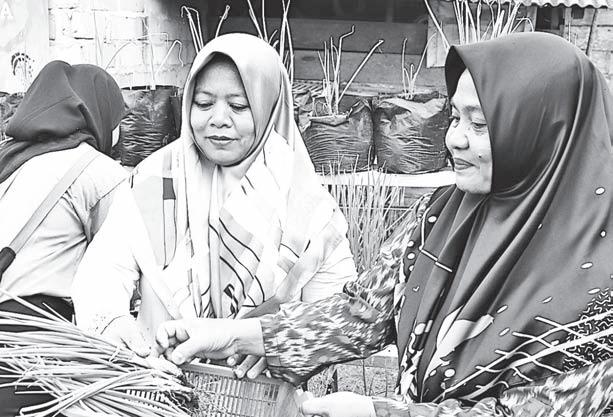
BALI, Indonesia—Seventyfive completed grant projects on biodiversity conservation and livelihood improvement in Indonesia were showcased in the recently concluded Small Grants Programme (SGP) Indonesia
Closing Forum.
The SGP is a regional program of the Asean Centre for Biodiversity (ACB), supported by Germany through the German Development Bank (KfW) that was designed to strike the balance between conservation and livelihood improvement in select Asean Heritage Parks (AHPs). AHPs, are protected areas that were recognised for their outstanding conservation value and effective biological resource management.
Since 2018, a total of €2.1 million were awarded to support small and micro-scale projects in Gunung Leuser National Park and Way Kambas National Park, two of the seven AHPs in Indonesia.
“For 2020 to 2022 alone, 34 projects focusing on biodiversity conservation and 41 on livelihood improvement were implemented by 33 grantee-organisations and 42 micrograntee-organisations across Indonesia,” said Clarissa Arida, ACB senior director for programs.
Arida added that local
communities, including the indigenous peoples living in the buffer zones of the AHPs and the AHP management, have been actively engaged in the program in varying capacities but mostly as grant beneficiaries.
“From ecotourism development activities, honey production, coffee plantation, eco prints in shawls and clothes, among others, are all heartwarming and the joy and delight in the faces of communities we visited are immeasurable,” she explained.
Dr. Indra Exploitasia, director of the Directorate of Biodiversity Conservation Species and Genetics of Indonesia’s Ministry of Environment and Forestry,
shared that the implementation of the SGP Indonesia has resulted in achievements on wildlife and biodiversity survey data.
Included in the survey were key species, such as the Sumatran elephant, rhino and tiger; ecosystem restoration activities combined with livelihood programmes to tackle human-wildlife conflict and tenurial conflict; and integrated ecotourism development as part of livelihood improvement.
“The SGP has contributed to the conflict resolutions in the two national parks Gunung Leuser National Park and Way Kambas National Park: humanelephant conflict, human-
tiger conflict, tenurial-related conflict, and social conflict in the communities,” Exploitasia said.
It has supported the livelihood improvement in 49 villages around these two parks, through community partnership programmes by promoting the alternative income generation for local community through non-timber forest products, organic farming, and ecotourism development, she added.
The forum highlighted how the SGP demonstrated the value of adopting a whole-ofsociety approach to biodiversity conservation.
“Striking the balance between economic development or improving the livelihood of communities and conservation is possible. Local communities, women, and other key stakeholders of the national parks should be treated as partners, not just beneficiaries,” said Corazon de Jesus Jr., coordinator of the SGP and director of the ACB Sustainable Use and Access and Benefit Sharing Department.
“All stakeholders have to be involved in the decision-making process for their heritage sites for us to come up with a conservation plan that will leave no one behind,” de Jesus added.
BRISBANE, Australia—
Just over two years ago, Firooza Amiri was an 18-year-old batter for the Afghanistan women’s cricket team, ready to take on the world if given the chance.

But just like that, her world and that of millions of others in her country changed forever.
Forced to flee with her family when the Taliban retook power in Afghanistan on August 15, 2021, Amiri and her family first traveled to Pakistan and then were evacuated to Australia. She still lives in Australia, along with most of her 25 teammates.
Now, looking for their place in international competition, they are pleading with the International Cricket Council (ICC) and the Afghanistan cricket authorities to give them a place to play, despite the Taliban’s ban on women in sport and education.
Yeah, unfortunately two weeks ago was the two-year anniversary of the Taliban and our BLACK DAY,” Amiri said in a message to The Associated Press, accentuating two words in capital letters.
A miri and her family were from the oasis city of Herat, then the third-largest city in Afghanistan with an estimated population of about 500,000.
It was a black day for me and all the girls of Afghanistan, the day our dreams were destroyed and all the efforts of many years of each of us were destroyed,” Amiri told the AP. “When Herat fell, we decided to go to Kabul and reach one of the foreign embassies. When we arrived in Kabul, we saw that Afghanistan had fallen completely to the Taliban and all the people were going to the airport to be able to leave the country, we did the same.”
From that point, the situation deteriorated.
“ It was very painful for me when I saw that all the girls, journalists, and politicians of Afghanistan were going to the airport and were leaving their country,” Amiri said. “For me, the most terrifying moment of my life was when I saw that there was shooting everywhere, people were screaming and crying, and even a young man had been shot five times... that was the moment when we stopped going to the airport and I and my teammates went to a safe house.”
A nother of Amiri’s teammates in Australia, Friba Hotack, was afraid her family would be targeted. Because my life was in danger,
AFGHAN CRICKETERS: HELP US PLAY AGAIN
Editor: Jun Lomibao
The ICC, in an emailed statement to the AP, said the Afghanistan Cricket Board operates autonomously and it cannot interfere.
The ICC board remains committed to supporting the Afghanistan Cricket Board and are not penalizing the ACB, or their players for abiding by the laws set by the government of their country,” the ICC said.
The relationship with players in any of the ICC’s member countries is managed by the board in that country, the ICC does not get involved. Similarly, the authority to field men’s and women’s national teams lies solely with the member board in any country, not with the ICC.”
A miri said the Afghan women’s team took heart from Australia’s decision in January to cancel a limited-overs series against Afghanistan scheduled to be played in the United Arab Emirates, where the men’s team is based. Cricket Australia cited recent heavier restrictions on women’s rights by the Taliban government for not playing the three games in March.
The cancellation was evidence, Amiri said, that some countries were serious about the rights of women to represent Afghanistan in the international sports arena. But she and some of her teammates don’t want the Afghan men’s team, which will play in the Cricket World Cup in India next month, to be banned from international cricket.
In my opinion, banning the men’s team is not a good way to create a team for us,” Amiri said. “Because the people of Afghanistan are fans of cricket, and by banning the men’s team, in addition to the fact that the people of Afghanistan will be saddened by the women’s team, our effort is to be able to get the support of the Afghan people.”
Unfortunately, she said, players on the national men’s team have “refused to stand with us.”
I separated from my family. I was in Pakistan for a month. I was afraid. I was very scared,” she told Australian Broadcasting Corp. radio earlier this year. Our dreams were shattered from the day the Taliban came. Everything— bat, cricket equipment, we burned everything because of the fear. The day we came to Australia, those dreams became alive again. We started to want to play again. We wanted to have a team here, to play cricket here.”
A miri and some of her former
teammates are doing just that, playing in a suburban league in Melbourne. But that’s a long way from the level they’re determined to be competing on. The Afghan men’s team travels the world and plays at the elite level. The women’s team wants a chance to do the same.
So Amiri and her teammates sent an email to the sport’s world governing body in December. Could you please advise what the official stance is on our national playing contracts and
future playing opportunities, noting that we are no longer living in Afghanistan?” they wrote.
The funding provided by the ICC to the ACB for the women’s program—where has this money gone? And can it be redirected to an organization in Australia to invest in our development...so we can still represent our country on the international stage?”
A miri added “we mentioned that we had been safely moved to Australia and that we know the
situation in Afghanistan but with your help and support...our hopes of representing our country remains alive. We are waiting for your leadership and your right decision.”
A miri says no one from the Afghanistan Cricket Board or ICC has contacted them.
“ We did not receive any help or even any hope from them, even though since 2017 they used the budget of men and women only for men and never supported the women’s team,” Amiri said.
MLB testing hands-free entry for fans using facial authentication, AI security
PHILADELPHIA—Major League Baseball (MLB) is testing facial authentication-based entry that would allow ticketed fans to walk directly into stadiums—a convenient new arrival method that the league says won’t compromise on safety and security.
No more fumbling for a phone at entry, waiting through a wonky bar code scan, or shuffling through a lengthy line at one gate to catch a baseball game at the home of the National League champions.
The Philadelphia Phillies have partnered with MLB to use their stadium as the site of a pilot program called Go-Ahead Entry, which uses facial authentication-based entry for ticketed fans.
Forget Shohei Ohtani or Bryce Harper, the faces of the game at Citizens Bank Park this week were the fans that snapped selfies through the MLB Ballpark app, breezed past a facial scan camera, and were soon hunting for their seats or nearest hot dog stand.
RYLA ORBISO ruled the women’s bikini, glamour and Procard bodybuilding categories to emerge with the most awards while Vilmor Rocamuada was named men’s bodybuilding overall champion in the recent World Fitness Federation (WFF) Mr. and Ms. Philippines 2023 Pro Qualifier at the Cuneta Astrodome in Pasay City. O rbiso was also the 30-above women’s glamour winner and Yangkee Solis topped the women’s short and overall figure divisions of the competition that gathered more than 200 participants and led by WFF Philippines head Rogelio “Roger” Bejemino and graced by WFF International president Graeme Lancefield of Australia.
B ejemino thanked Get Wheysted Philippines for supporting the sport and Filipino bodybuilding athletes in the event that saw Jeczar Manzanares (65 kgs) Jonniel Molina (70 kgs), Jomar Rivada (75 kgs), Ferdinand Clet Bancoro (Masters), Rolando Barnayha (Grand Masters) and Ruben Joriz Bolo (Pasay Exclusive) coming out triumphant in
A FACIAL scan camera is seen at Citizens Bank Park before a baseball game between the Los Angeles Angels and the Philadelphia Phillies Tuesday in Philadelphia. AP
Sports fans have long adjusted to electronic tickets on smartphones, and have the capacity to order everything from chicken fingers to foam fingers on devices from their seats without missing a pitch, punt or
power play.
N ow comes hands-free entry to one ballpark—one that takes advantage of existing contactless security protocols. Fans have eagerly used the technology so
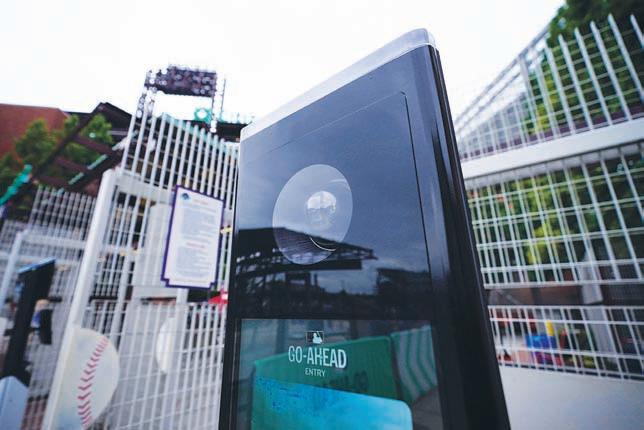
far, even after safety fears were heightened after Chicago police said a shooting that wounded two women at Friday night’s AthleticsWhite Sox game most likely involved a gun that went off inside Guaranteed Rate Field.
K arri Zaremba, MLB’s senior vice president of product, said Go-Ahead entry had been in the works for more than two years. The program— complete with Go-Ahead banners at the first base gate directing fans— was launched August 21.
A ll Phillies fans entering through the first base and left field gates could already walk through security screening without having to stop to open bags or be checked individually. The Phillies use Evolv Technology, which uses AI sensor technology to expedite entry and eliminate the need to remove cell phones, cameras, coins, and keys and place them in a screening bowl, or to have patrons checked individually with metal detecting wands.
These are the most advanced
security systems on the market today,” Zaremba said. “That is a completely separate step as part of [Go-Ahead], but we pair it together because both support free flow.”
Evolv technology is used at select other stadiums, such as Fenway Park and SoFi Stadium, and puts a premium on safety. Baseball fans and players say they’ve always felt safe at the ballpark.
I can’t remember a time where I felt scared of another human at a ballpark,” Phillies outfielder Brandon Marsh said. “That’s never on my mind. I’m worrying about the task and job at hand. There’s already a lot to worry about.”
Jason Ritchie, from Bath, Maine, road-tripped to Philly with his 13-year-old son to watch four Phillies games and used the Go-Ahead entry for everyone. Ritchie said he had no concerns about the program and appreciated the volume and speed— an E-ZPass, of sorts, for humans— the cameras could handle that made entry a snap. AP
Orbiso, Rocamuada victorious in WFF Mr. and Ms. Philippines contest
Their only answer to us was that we are endangering our families by doing this,” Amiri said. “The Afghanistan Cricket Board has not done anything for the development of women’s cricket for years.”
W ith a second anniversary of the Taliban takeover just passed, Amiri can’t forget the turmoil.
For me, every year this day is a reminder of all the moments that I experienced when I was 18, the age when we all [should] study and pursue our dreams,” she said. The entire world can see, she added, “That the girls in Afghanistan don’t have the basic right of society, which is education.
It’s painful for me to imagine that if I was in Afghanistan, would I be alive or not?”
A fghanistan’s female athletes are receiving support from one of the country’s first female Olympians— Friba Rezayee, a judo competitor at the 2004 Athens Games. Rezayee has started a petition asking the International Olympic Committee to “recognize the Afghan female athletes independently, not the Taliban NOC [National Olympic Committee].”
The Afghan women’s team hasn’t had a chance to play international cricket, yet. Amiri remains optimistic.
I would like to say thanks to Australia and all the people who have helped us to live safely,” she says. “We believe that magic will happen one day and we will represent our country on an international ground in the world.”
To further illustrate her point, the slogan on one of Amiri’s messaging apps says: “Gonna take more than a human to stop me from where I am meant to be,” and includes a muscleflexing arm, a cricket bat and ball, and a flag of Afghanistan. AP
I n the Bermuda beach model category, Joseph Galvez was the overall champion and shared the stage with Rafael Xius Del Rio (Natural) Pocholo Marco Ducay (Juniors), Jed Keoni Uy Jolo (Short), Joseph Galvez (Tall), Christopher Amores (30 above), Noel Conception (Physically Challenged) and Ruben Joriz M. Bolo (Pasay City Exclusive).
The other Procard winners were Galvez in bermuda beach model and aclan in men’s sports model.
The event was staged in partnership with the Pasay City government led by Mayor Imelda Calixto-Rubiano and Councilor Donnabel Vendivel.
The event also solidified WFF Philippines’ position as the premier bodybuilding and fitness organization in the country, opening new doors and opportunities for athletes and enthusiasts alike,” Bejemino said.


men’s bodybuilding. There were 38 divisional competitions in eight major categories in the event that lasted 12 hours and highlighted by the participation of 82-year-old
The
jeans
and Above 30 categories, while Jovenal Aclan Jr. (Short and Overall) and Amores (Tall) winning in the men’s sports model contest.
L ancefield, on the other hand, praised the meticulous organization and execution of the event as he bared his excitement over future collaborations with WFF Philippines as he eagerly anticipate his role in upcoming monumental events.
The math problem: How schools can help kids catch up


Publisher :
Editor-In-Chief :
Concept :
Y2Z Editor :
SoundStrip Editor :
Group Creative Director :
Graphic Designers :
Contributing Writers :
HALLELUJAH!
The crazy night Binky Lampano drove away the blues
Do people in your workplace know that you’re a famous artist and musician in Asia?
“FAMOUS” is a loaded word. Never really disclosed anything about my preoccupations at work, let alone go beyond whistling or humming out of tune or context.
There were a few enterprising students and an old client who doxed me, but they were nice enough not to spread the word around.
I’ve learned how to compartmentalize my work and so-called “passion” (or lack thereof) for my own sanity. This is Lala-Land after all, and I dread being a performing bear.
Text and photos by Francine Y. MedinaTHE country’s foremost blues performer Binky Lampano held the second of his two-series shows at 19 East on August 16 (the first at 78-45-33 in Makati on August 4) and it was a riot. The second show was organized by the Philippine Blues Society (PBS).
T. Anthony C. Cabangon

Lourdes M. Fernandez
Aldwin M. Tolosa
Jt Nisay
Edwin P. Sallan
Eduardo A. Davad
Niggel Figueroa
Anabelle O. Flores
Tony M. Maghirang, Rick Olivares, Patrick Miguel
Jill Tan Radovan
Reine Juvierre Alberto
John Eiron R. Francisco
Photographers :
Bernard P. Testa
Nonie Reyes
Y2Z & SOUNDSTRIP are published and distributed free every Sunday by the Philippine Business Daily Mirror Publishing Inc. as a project of the

The Philippine Business Mirror Publishing, Inc., with offices on the 3rd Floor of Dominga
Building III 2113 Chino Roces Avenue corner
Dela Rosa Street, Makati City, Philippines.
Tel. Nos. (Editorial) 817-9467; 813-0725.
Fax line: 813-7025
Advertising Sales: 893-2019; 817-1351,817-2807.
Circulation: 893-1662; 814-0134 to 36. www.businessmirror.com.ph
Binky flew in from California where he is based and leads a relatively quiet but thriving life in the IT business as a systems administrator “in the morning and a cybersecurity instructor on certain nights for two community colleges in the LA district.”
Binky, a pioneering figure in the country’s alternative music scene that burgeoned in the 90s, reveals that his days are mostly filled talking hardware/software installs, upgrades, server work, cybersecurity breaches, how to mitigate them, and all that techie razzmatazz.
Akin to the OFW dream, Binky had just bought a house in Batangas for when it’s time to, as he says, “ride off into the sunset” with his wife Donna, a yoga teacher. Their only son Jakob is a filmmaker working in Hollywood.
To say that Binky delivered an excellent show at 19 East is an understatement. Performing with his band Lampano Alley, Binky gave an experience and showed that after all these years, blues for him goes beyond being a genre but part of his core as an artist. The guy has long earned his dues.
Singing with such power and intensity, it was a rare night spent with old friends and peers. Binky sang the familiar tunes—from B.B. King, Jimmie Cox to his own compositions—peppered with his classic wit, ruminations, and loose dance. Only this time, the fieriness of his youth has subsided and replaced with the wisdom of a man at peace since embracing Judaism a couple of years back. He’s also seen wearing a kippah (head cover) as part of his faith’s practice.
“The most important thing is that we’re still here,” he pensively said to the crowd of familiar faces.
“We love you, Binky!” someone from the crowd shouted.
“And I love you guys back,” he said. Energy just wonderfully suffused at 19 East that night, beginning with the lilting music of Aki + Kwakoy, featuring vocalist Aki Merced and guitarists Kwachi Vergara and Kakoy Legaspi. Next up was the formidable all-star Blue Rats (Joey Puyat, Andy Locsin, et. al.) with vocalist Jamie Wilson jamming with Binky at one point. PBS president Eddieboy Santos also delivered as the show’s efficient emcee as he shared notes about the performers.
And of course, the main act, Binky and the powerhouse Lampano Alley with Simon Tan and Edwin Vergara on guitars, Ray Vinoya on drums, and Ian Lofamia on blues harp.

Binky allowed his band to lead the night, as he just moved and sang with such spontaneity, palpably allowing himself to get lost in both his movements and songs with such free spiritedness.
“I wouldn’t know what’s going on until the first note these days,” he revealed in this interview. “We allowed the magic to happen aided and abetted by our audience. Funny what time does to music—there’s an interesting point in the tunes we played where everything just feels half-remembered and the music becomes a pure stream of consciousness. You get to an unknown place where you’re only lost in wonder, until it’s time to move on to another.”
A memorable night catching up with Binky and the blues scene. After a long period of quietude within the PBS community, understandably due to the pandemic, it just feels so good to be home with Binky again.
Here’s more of “the word” from this incredible artist and philosopher:
Music as a grind never appealed to me. Why should it ever be a chore? I went out of business a long time ago. These days, music never goes beyond the confines of our flat or car, for the most part. I’m satisfied in my capacity to just be a part of the woodwork from day to day. Nobody calls me by my industry name. It’s all good in the ‘hood.
How does it feel to do two shows here that were both well received?
I’M always gratified and elated. Gratified because I’m not getting in the way of the music. I’m really elated because of long-time cohorts and friends who are still around and the fact there are still new ones to be made after all these years. You already hit the jackpot when you leave good feelings. There was a point when you went down from the stage and worked your way around the audience. What was that song you performed?
ONE that always comes to mind is “Nobody Knows You When You’re Down and Out”, a Jimmie Coxblues standard from the 1920s, and “Ganyan Lang”—“loser” tunes tell the truth of success and failure. They remind one of real friends, not those who were only there during “Instagrammable” moments (as the saying goes). I’m fortunate to have real friends who were there through thick and thin. A few have gone ahead, whom I miss dearly to this day – they really made a difference in my life. If it weren’t for them, I’d be an embarrassing mess for my age.
You also said, “Keep living while we’re still breathing” Or was it “Keep breathing while we’re still living”?
TO live—or to appreciate life—is the work cut out for us in this plane of existence. Hopefully, I can make life a little better for others by being less of a pain-in-the-ass, give my utmost to be worthy of every breath that I still have. Never thought in my wildest dreams that Lampano Alley, let alone our friends and listeners, could come this far.
It’s been a great thrill and honor. May it stay that way for a good while to come. Until then, may we all be blessed with the strength to endure, the courage to keep that sense of wonder, and the good health to stick around for more. Thanks much for everything. Until we meet again.
‘A LOT OF STUFF WITH LOVE’
Zack Tabudlo’s new single is for the hopeless
By Reine Juvierre AlbertoOPM singer-songwriter and producer Zack

Tabudlo is back with a new single, “Ako Nalang Kasi,” and there’s no stopping this talented artist from making music that continues to resonate with his growing fanbase.
Almost 6 minutes in length, “Ako Nalang Kasi ” translates Zack’s unwavering passion to a song that is full of yearning for someone whom he just wants to dance with under the pouring rain.
“Ako Nalang Kasi ” sounds dreamy and hopeful but also very eager, like a promise of a love that is already there— longing for it to come around. The 21-year-old’s soft and ethereal voice in the first part of the song becomes an urgent plea.
“I wrote the song last week, and the label agreed to release it as soon as possible,” he told SoundStrip in an interview during the single launch at SaGuijo Cafe + Bar last August 22.
There’s no denying Zack’s expertise in producing songs.
With “Pano,” it only took him 10 minutes to write the entire song, while most of his songs that gained a lot of attention started from scratch, and eventually, he finished writing those for “a few minutes or an hour.” Then, he’ll finish the production in a day or two and submit it to his label right away.
(Un)Reciprocated
WHEN asked about his inspiration behind the new song, the 6-foot-tall Zack gently smiled and confessed he was “going

romantics
through a lot of stuff with love as well.”
He admitted during the interview that he liked someone, who was always a friend of his, and just reciprocated the lyrics into the things he was going through at that time.
“Parang ako na lang kasi nandito naman ako for a very long time,” he pointed out candidly.
His songwriting, deriving from his personal experiences, seizes the sentiment of a person who just wants to be seen as someone capable of loving, who is not afraid, who will sacrifice and give everything just to provide a steady kind of love, and try their best not to hurt that special someone.
Kunin mo na aking mga kamay
Ikaw ay mamahaling tunay
Sumandal ka sakin
Ako ay yakapin
Ako nalang kasi ang ‘yong mahalin
Zack recalled his earlier songs like “Pano,” with alt-pop and R&B sounds, the slow and romantic “Binibini,” and the dancy “Habang Buhay,” were all meaningful and attributed those to the growth of his successful career.
In “Ako Nalang Kasi,” he retraced his roots and reconnected with his musical identity after venturing to different sounds and styles throughout his eras, but still gives the same kind of “vibe” with a bit of twist.
By incorporating techniques he learned throughout the years as a musician and producer, the song has Zack’s “unique touch” combined with a fresh layer of depth.
“I want everyone to feel the old vibes and how I started everything,” he expressed.
The story so far
THE year 2023, for Zack, has been a rollercoaster ride because it had “a lot of ups and downs,” from rumors to milestones.
He started the year by winning the Wishclusive Rock/Alternative Song of the Year with “Asan Ka Na Ba” in the 8th Wish Music Awards, and released new music in the succeeding months with his second album, “ZACK: FOR ALL,” which he shared his writing, producing, mix and mastering this album as a “one hell of an experience” making it his own.
He was able to release some of his new songs that are heavily influenced by funk, 70s soul, and R&B. “There’s a lot of artistry that came out in me when I did all those tracks just going back,” he beamed.
He also released a couple of singles and collaborated with other artists like
rock duo joan; and rappers Al James and Nasty C, who are of different genres but familiar to him.
When he was still in Los Angeles, he recalled producing music for hip-hop artists and working with producers when he was just starting off. Through that, he found satisfaction in finishing every track and producing music.
With it being his “original thing,” he shared during the interview: “Delving into Al James and Nasty C are kind of like roots for me, kind of like going back to the past as well when I started off this whole music thing.”
Now, Zack is the first solo Filipino male artist who has surpassed 1 billion streams on Spotify. The sensational singer-songwriter credits this milestone to his team and record label, who have been part of his success since day one; to the people who listen to his music; and to his loyal fanbase, who remains by his side.
Zack also gives credit to TikTok, where a lot of people use his songs in their videos. “Once they use it, that’s when it blows up,” he mentioned.
To the world
ZACK is also poised for global success as no less than BTS member Jungkook listened to his track “Give Me Your Forever”’ during a live video while another K-Pop star, ENHYPEN’s Heesung recorded a cover of the same song.
For the rest of 2023, Zack quipped, “We’ll see how it goes. I’m still going to release a bit of songs for this year,” teasing on his Instagram account the song “Delulu,” a Gen Z term for delusional.
He also wants to explore more genres like jazz and hip-hop and mix them with his own distinctive brand of pop music.
From also performing shows in Asia, now, he declared: “I think I’m going to have my world tour soon.” With its official announcements in the horizon, that’s one good news fans will be looking forward to sooner rather than later.
The math problem: How schools can help kids catch up
by Ariel Gilreath of The Hechinger Report & Jackie Valley of The Christian Science Monitor The Associated PressOne by one, they raced to a table, where they scribbled answers to multiplication questions before sprinting back to high-five their teammate. These students are part of a summer program run by the nonprofit School Connect WA, designed to help them catch up on math and literacy skills lost during the pandemic. There are 25 students in the program, and all of them are one to three grades behind.
One 11-year-old boy couldn’t do two-digit subtraction. Thanks to the program and his mother, who has helped him each night, he’s caught up. Now, he says math is challenging, but he likes it.
Other kids haven’t fared so well.
Across the US, schools are scrambling to catch up students in math as post-pandemic test scores reveal the depth of missing skills. On average, students’ math knowledge is about half a school year behind where it should be, according to education analysts.
Children lost ground on reading tests,

#GirlMaths
too, but the math declines were particularly striking. Experts say virtual learning complicated math instruction, making it tricky for teachers to guide students over a screen or spot weaknesses in problem-solving skills. Plus, parents were more likely to read with their children at home than practice math.
The result: Students’ math skills plummeted across the board, exacerbating racial and socioeconomic inequities in math performance. And students aren’t bouncing back as quickly as educators hoped, supercharging worries about how they will fare in high school and whether science, tech and medical fields will be available to them.
‘A generation’s worth of progress lost’
StUdENtS had been making incremental progress on national math tests since 1990.
But over the past year, fourth and eighth grade math scores slipped to the lowest levels in about 20 years, according to data from the National Assessment of Educational Prog-
ress, known as the “Nation’s Report Card.”
“It’s a generation’s worth of progress lost,” said Andrew Ho, a professor at Harvard University’s Graduate School of Education.
At Moultrie Middle School in Mount Pleasant, South Carolina, Jennifer Matthews has seen the pandemic fallout in her eighthgrade classes. Her students have shown indifference to understanding her pre-algebra and Algebra I lessons.
“They don’t allow themselves to process the material. They don’t allow themselves to think, ‘This might take a day to understand or learn,’” she said.
And recently students have been coming to her classes with gaps in their understanding of math concepts. Basic fractions, for instance, continue to stump many of them, she said.
A complicated computation
AddING to the challenge of catching kids up is debate over how math should be taught. Over the years, experts say, the pendulum
has swung between procedural learning, such as teaching kids to memorize how to solve problems step-by-step, and conceptual understanding, in which students grasp underlying math relationships.
“Stereotypically, math is that class that people don’t like. For so many adults, math was taught just as memorization,” said Kevin dykema, president of the National Council of teachers of Mathematics. “When people start to understand what’s going on, in whatever you’re learning but especially in math, you develop a new appreciation for it.”
Even at a nationally recognized magnet school, the lingering impact of the pandemic on students’ math skills is apparent. At the townview School of Science and Engineering in dallas, the incoming ninth graders in Lance Barasch’s summer camp course needed to relearn the meaning of words like “term” and “coefficient.”
“Then you can go back to what you’re really trying to teach,” he said.
Barasch wasn’t surprised that the teens were missing some skills after their chaotic middle school years.
The hope is that by taking a step back, students can begin to move forward.
n The Education Reporting Collaborative, a coalition of eight newsrooms, is documenting the math crisis facing schools and highlighting progress. Members of the Collaborative are AL.com, The Associated Press, The Christian Science Monitor, The dallas Morning News, The Hechinger Report, Idaho Education News, The Post and Courier in South Carolina, and The Seattle times.
Cover photo by Mikhail Nilov on Pexels.com
A seemingly fun way to justify expenses can have serious financial consequences
‘THESE shoes are perfect, made for me! I have to get them! But really, I should be paying off my car loan instead. I can’t justify this purchase. Or can I …?”
We all know this feeling, this tension between what you really want to do and what you really should, or shouldn’t, do. This is called cognitive dissonance, a psychological discomfort we feel when our behaviors and our values or beliefs do not match.
Not to worry, we can make that discomfort simply disappear with a good dose of #GirlMaths!
What is it?
GIRLM At HS recently became a viral phenomenon on tiktok after New Zealand
FVHZM radio hosts Fletch, Vaughan and Hayley used #GirlMaths to justify one host’s mother’s expensive dress purchase as basically free because the dress was going to be worn at least four times.
Since then, influencers have added to the #GirlMaths trend with gems such as “If I buy it for $100, wear it, and then resell it
for $80 then I basically wore it for free,” “If I pay with cash, it means it’s free,” and “If I just returned something, then purchase something new for the same amount of money, then it’s free.”
The reason #GirlMaths resonates so well with everyone and allows it to go viral is that we are very familiar with this type of thinking. The mental gymnastics of #GirlMaths needed to justify cost-per-wear or cash-is-free is a perfect display of behavioral biases and heuristics, such as confirmation bias and denomination bias, being applied to everyday consumption decisions.
The psychology of decision-making
BEHAVIORAL biases and heuristics are shortcuts in our thinking that help us make decisions quicker and easier, and are great for reducing the cognitive dissonance we sometimes experience.
Our brain has a lot of decisions to make in a day and simply doesn’t have the power to scrutinize every little detail of every decision. These shortcuts in our thinking may
facilitate the decision-making process, but they don’t always mean we make the most optimal decisions.
The financial and social costs
BU t it’s all a bit of innocent fun, right? Surely people won’t take #GirlMaths that seriously? We beg to differ.
First, the term is unnecessarily gendered. Gendered language operates to reinforce societal expectations with a particular gender and can promote stereotypes, biases and binary categories. In this case, the term “girl maths” reinforces problematic stereotypes that equate women with consumption, frivolity and extravagant spending. When stereotypes are reinforced within our own social circles, we are more likely to internalize these as part of our identity.
Second, the #GirlMaths trend reminds us of the power of “finfluencers”—social media content creators amassing huge online followings by sharing advice on anything from budgeting to buying a house, to investing.
These online gurus appeal to Gen Z and millennials, simplifying complex financial concepts into digestible nuggets, much like #GirlMaths simplifies purchases based on cost-per-wear or cash-as-free.
However, the convenience of these shortcuts in our thinking can obscure the hidden financial risks. You may overlook the bigger picture of your financial health, and spend more than what you can afford.
The perils of #GirlMaths
tHE danger of #GirlMaths to young women lies in the cocktail of feeling oddly familiar and reinforced in this biased thinking, the problematic stereotypes that shape identities, and the power of finfluencers, who wield increasing influence over the financial choices and decision-making of young women.
While the term may initially come across as innocent fun, it’s crucial not to underestimate its potential harms. Instead, let’s champion the use of inclusive language in finance that doesn’t perpetuate gender biases. The Conversation

On a breezy July morning in South Seattle, a dozen elementaryaged students ran math relays behind an elementary school.Giada GaMbiNo, 10, grows frustrated with a problem on a math worksheet from school as her mother helps her work through it at the dining room table in their home on august 23, 2023, in Spring, Texas. AP
